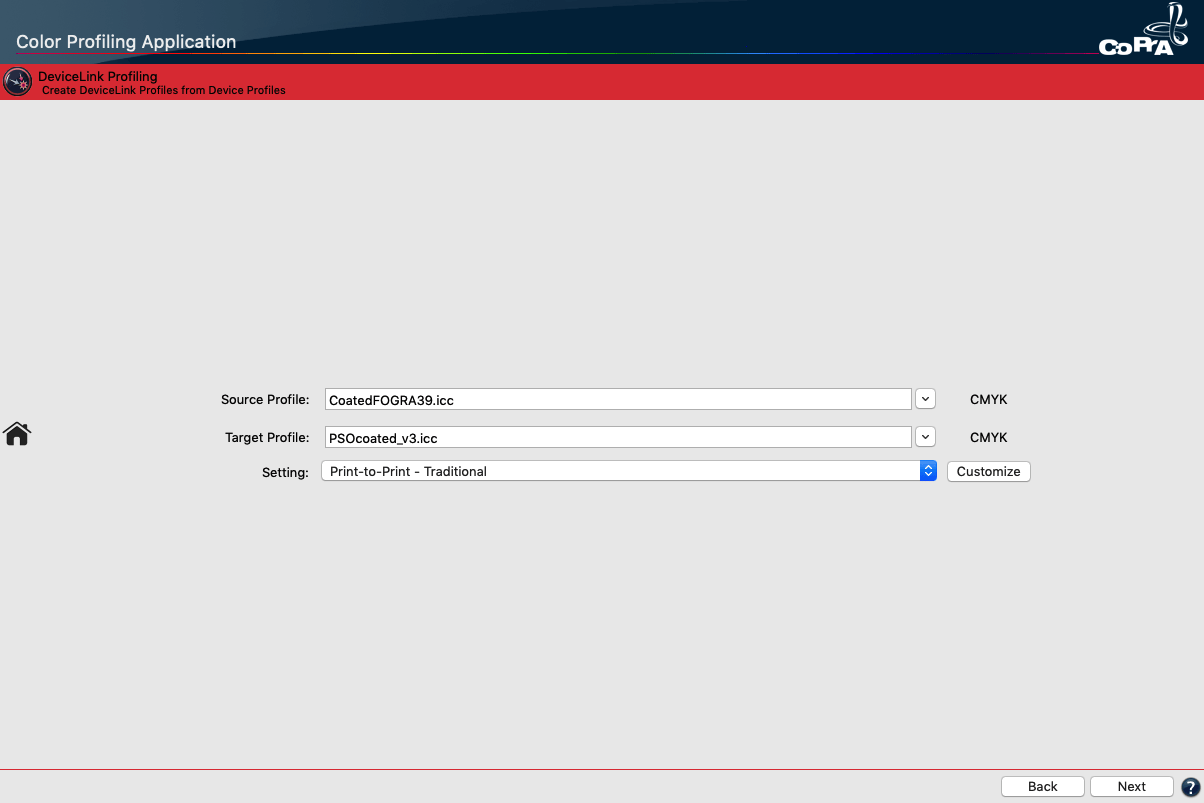
Creating DeviceLinks
Overview
DeviceLink profiles offer some advantages in comparison to device profiles:
- DeviceLink profiles perform a direct conversion between input and output color spaces. Color values or color combinations can be protected or individually customized and will only be altered where necessary.
- DeviceLink profiles compensate for many weak points of conversions using ICC output profiles. For example, the DeviceLink allows preservation of the black channel so that black text is printed with black ink rather than using four inks.
- Ink can be saved (SaveInk) or the total area coverage (TAC) reduced without altering other color areas.
- In proofing iterated DeviceLinks also provide a substantially increased proof quality.
Supported Color Systems
CoPrA allows to create DeviceLinks for all types of color spaces Gray, RGB, CMYK and Multicolor. Cross color space profiles are also supported, such as RGB to CMYK, CMYK to Grayscale or RGB/CMYK to Multicolor.
The following color systems are supported:
- 2- and 3-color systems
- 4-color systems with CMYK
- 4-color systems with CMY + either Red or Green or Blue, without Black
- 5-color systems: CMYK + either Red or Green or Blue
- 5-colour systems: CMY + either Red+Green, Red+Blue or Green+Blue, without black
- 6-colour systems: CMYK + either Red+Green, Red+Blue or Green+Blue
- 6-colour systems: CMY + Red+Green+Blue, without Black
- 7-colour systems: CMYK + Red+Green+Blue
- 8-color systems: CMYK + Red+Orange+Green+Blue
- 9-color systems: CMYK + Red+Orange+Green+Blue+Violet
- The CMY channels can even be exchanged for other similar colors, e.g., Magenta for another reddish color or Yellow for Beige and so on.
- Creation of DeviceLinks with up to 9 channels
Arguably, the most important applications are conversions of CMYK-to-CMYK, RGB-to-CMYK, CMYK-to-Multicolor and Multicolor-to-Multicolor. DeviceLink profiles thus complement the color conversions of ‘typical’ ICC output profiles and are often used for special applications in order to achieve significantly better results, for example in conversions of CMYK data for various printing processes.
ICC printer profiles are needed to create DeviceLink profiles. If you do not have printer profiles yet, you can easily create them in CoPrA (using the tool Printer Profiling from the sidebar).
Select Source and Target Profile
Select profiles
A DeviceLink profile converts colors directly from the source to the target color space in a single profile. Every color value of the source color space is therefore directly converted into a specific color value of the target color space. Source and target color space can be different or identical depending on the intended use of the DeviceLink profile. The tool DeviceLink offers the following options:
- Source Profile: Specifies the source profile for the conversion.
- Target profile: Sets the target profile.
- Setting: Select one of the PREDEFINED settings (for example Proofing or Print-to-Print) or an edited setting. Predefined settings can be modified and saved.
- Customize: Modify the DeviceLink settings to improve profile quality. Allows to specify the Rendering, the Exceptions and the Color Generation. Customized settings can be saved.

Note: All profile drop-down menus function like search fields. Simply type in some letters of the desired profile and only those profiles containing these letters will be shown in the list. To select a profile simply click on it.
When a DeviceLink profile is selected in which source and target profiles are embedded (including SaveInk profiles), CoPrA can use these profiles directly from the DeviceLink.
This eliminates the need to install the profiles on the system before the DeviceLink is used.
Setting: Select a suitable PREDEFINED setting for the creation of the DeviceLink profile from the drop-down menu. The names of the presets are based on typical tasks in printing.
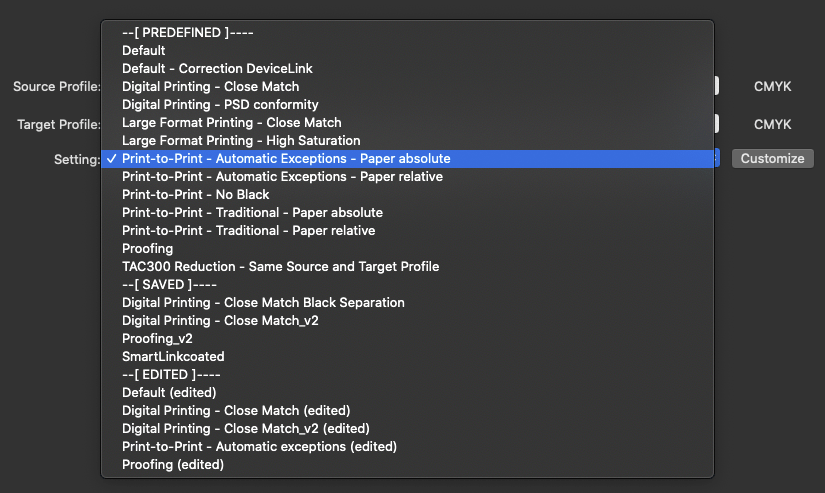
Default: Start with this preset if none of the other presets match your requirements. Then adapt to your needs.
Auto Channel Settings with TAC from Target Profile: Only available when using 5CLR – 9CLR target profiles. This setting uses the black calculation method Auto based on Target Profile and the channel settings Auto for the Channel Definition and the Channel Combination.
Default – Correction DeviceLink: Default setting for creating a Correction DeviceLink profile.
Default – Multicolor: Standard presetting, which provides a good starting point for adaptations to special requirements.
Digital Printing – Close Match: For digital prints that look as similar as possible to the source profile. Achieves the closest possible match between two color spaces, e.g., to achieve a match similar to a proof but without paper simulation and avoiding washed out shadows.
Digital Printing – PSD conformity: For digital prints according to “Fogra ProcessStandard Digital Printing”.
Digital Printing – Paper absolute: Uses a paper absolute rendering with consideration of the paper tone.
Digital Printing – Paper relative: Uses a paper relative rendering without consideration of the paper tone.
Large Format Printing – Close Match: For large format prints that look as similar as possible to the source profile. Achieves the closest possible match between two color spaces, e.g., to achieve a match similar to a proof but without paper simulation and avoiding washed out shadows.
Large Format Printing – High Saturation: Results in more saturated large format prints.
Print-to-Print – Automatic exceptions: For offset or newspaper printing. Exceptions are determined automatically and the separation properties of the source profile are retained.
Print-to-Print – Automatic exceptions – Paper absolute: For offset or newspaper printing. Exceptions are determined automatically and the separation properties of the source profile are retained. Uses a paper absolute rendering with consideration of the paper tone.
Print-to-Print – Automatic exceptions – Paper relative: For offset or newspaper printing. Exceptions are determined automatically and the separation properties of the source profile are retained. Uses a paper relative rendering without consideration of the paper tone.
Print-to-Print – No Black: Creates a DeviceLink profile without black separation. The exceptions are set so that no black is generated.
Print-to-Print – Traditional: For offset or newspaper printing. Exceptions are predefined and the separation properties of the source profile are retained.
Print-to-Print – Traditional – Paper absolute: For offset or newspaper printing. Exceptions are predefined and the separation properties of the source profile are retained. Uses a paper absolute rendering with consideration of the paper tone.
Print-to-Print – Traditional – Paper relative: For offset or newspaper printing. Exceptions are predefined and the separation properties of the source profile are retained. Uses a paper relative rendering without consideration of the paper tone.
Print-to-Print – Paper absolute: Uses a paper absolute rendering with consideration of the paper tone.
Print-to-Print – Paper relative: Uses a paper relative rendering without consideration of the paper tone.
Print to Print – Preserve Color Properties: For Multicolor-to-Multicolor DeviceLinks. Selects the appropriate Multicolor Mode and all other settings automatically.
White Ink + 3 Primaries – Printing on Black substrate / White Ink + 4 Primaries – Printing on Black substrate: For color managed color prints on black substrates, such as textiles, white ink must be used first and colors must be applied on top of the white ink to obtain colorful graphics. This preset uses White for the separation. It automatically selects the appropriate Multicolor Mode – either CMY+White_on_Black or CMYK+White_on_Black – while all other Color Generation controls are disabled.
Note: To create profiles with White, special test charts are required, which can be found in the test charts subfolder Special for the two cases CMY+White_on_Black and CMYK+White_on_Black.
Proofing: For proofing applications. The rendering intent is set to absolute colorimetric and all exceptions are disabled.
TAC300 Reduction – Same Source and Target Profile: To set the ink application reliably to 300% in your print data. Note that the source and target profiles must be identical.
Working with Profile Settings
Import, Export or Cleanup of Profile Settings
Profile settings for Printer, DeviceLink and SaveInk profiling can be selected in the drop-down menu Setting.
The package CoPrA Basic allows selection of default predefined settings. The package CoPrA M and higher provides access to all the parameters of the profile which can be customized.
To adjust these profile parameters, select Customize. Custom settings can be saved, imported and exported which provides the ability to exchange personal profiling settings easily with other CoPrA users or make them available for support purposes.
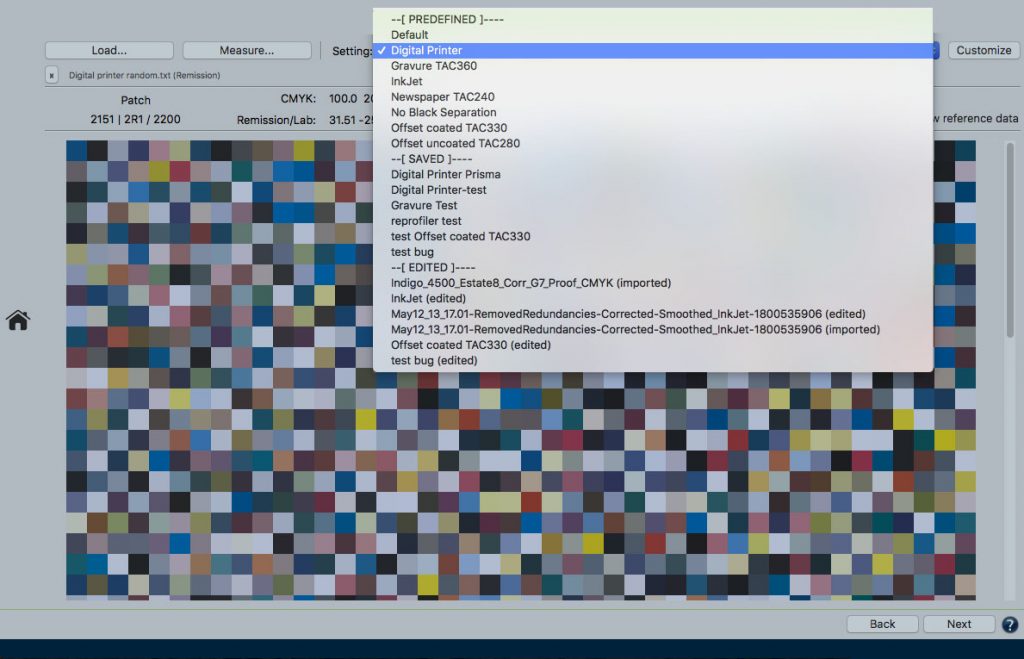
Import setting: Settings can either be imported as configuration file via the Tools menu using the entry Import setting or by dragging an ICC profile with the desired settings on the drop-down menu Setting. The name of imported profiles receives the suffix (imported). If an inappropriate profile (for example an RGB profile for CMYK profiling) is dragged on the drop-down menu Setting, an error message appears.
Export setting: Customized profile settings can be selected in the drop-down menu Setting and exported as configuration file by using the entry Export setting from the Tools menu.
However, CoPrA’s default settings cannot be exported. Standard settings are listed in the drop-down menu Setting under the entry [PREDEFINED] and can be customized, but they cannot be overwritten. After customizing any setting the name receives the suffix (edited). It is now a custom setting which is listed under the entry [EDITED] and thus can be exported. Edited settings can be saved under any name. Saved settings will be removed from [EDITED] and listed under [SAVED]. Saved and edited settings can be deleted manually.
Cleanup settings: All settings found under the entry [EDITED] will be deleted.
Sharing settings with ZePrA (CoPrA 5 and lower)
Due to the close connection between CoPrA (ColorLogic’s profiling solution) and our color server ZePrA, the profile settings from CoPrA can be used to calculate DeviceLink profiles in ZePrA.
By selecting the checkbox Share with ZePrA in CoPrA, the settings of your DeviceLink and SaveInk profiles are transferred directly to ZePrA and can be used there as SmartLink Method.
The SmartLink Method in ZePrA allows calculation of the necessary DeviceLink and/or SaveInk profiles for the conversion of PDF files on-the-fly, without the need to create these DeviceLinks in advance.
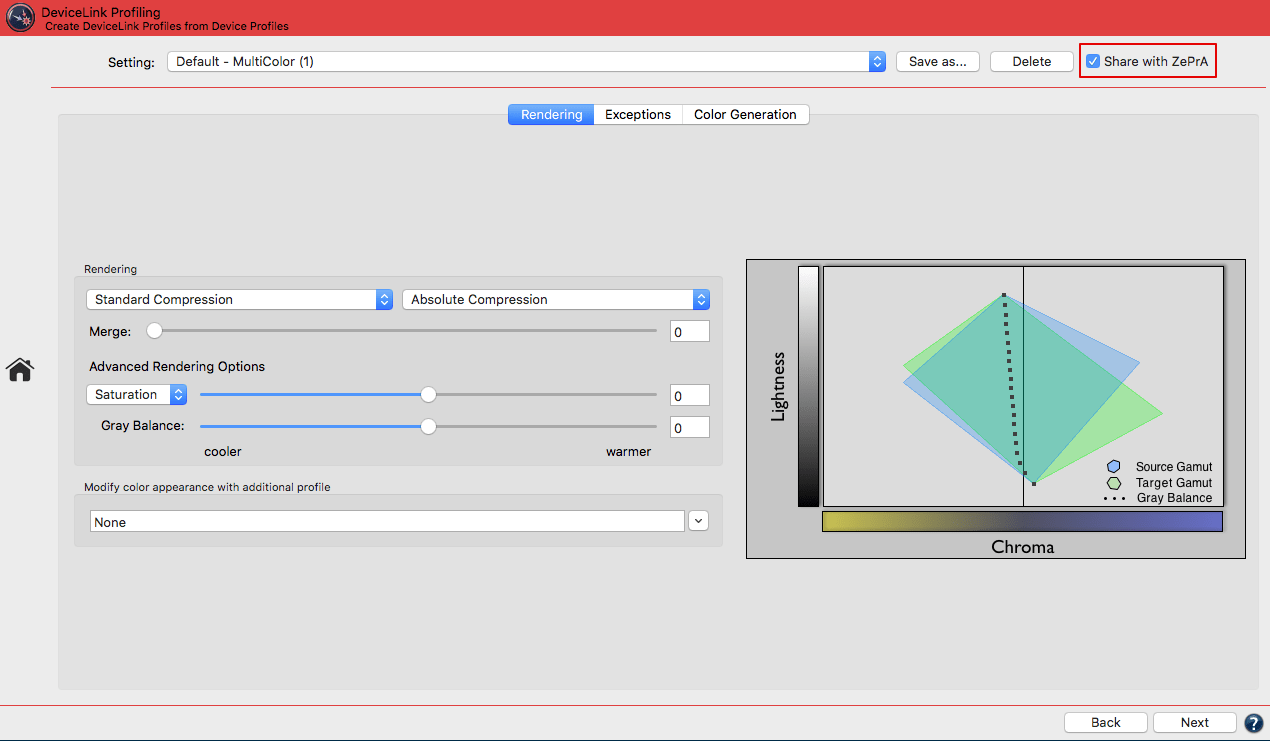
The DeviceLink tool in CoPrA: SmartLink can use the profile settings from CoPrA to create DeviceLinks in ZePrA
To do so, make all the required settings in CoPrA by entering all relevant information in the DeviceLink tool under Rendering, Exceptions, and Color Generation. Click Save As and enter a name for the setting. Confirm with OK, then activate the Share with ZePrA checkbox.
The so created methods shared with ZePrA are then available as SmartLink Method in the drop-down menus of both the Auto Setup and the Configurations.
Note: Only saved settings can be shared with ZePrA. Default or edited presets cannot be shared.
Sharing settings with ZePrA (CoPrA 6 and higher)
The SmartLink Method in ZePrA allows to create DeviceLinks and SaveInk profiles for the conversion of PDF files on-the-fly, without the need to create these DeviceLinks in advance.
Due to the close linkage between CoPrA and ZePrA, profiling settings specified in CoPrA can be used by ZePrA to create the required profiles.
The settings are accessible via a shared folder which has the advantage that CoPrA and ZePrA do not need to be installed on the same computer. The shared folder must simply be accessible by both ZePrA and CoPrA, either over the network, a shared local folder or the cloud.
Procedure
In CoPrA
- Under Preferences, enable the checkbox Share CoPrA Settings with ZePrA Auto Import Folder and select ZePrA’s Auto Import folder.
Note: The Auto Import folder must be activated in ZePrA as well.
If the checkbox is enabled and the Preferences dialog closed with OK an information message will appear asking the user if all shared presets should now be copied to the defined Auto-Import Folder.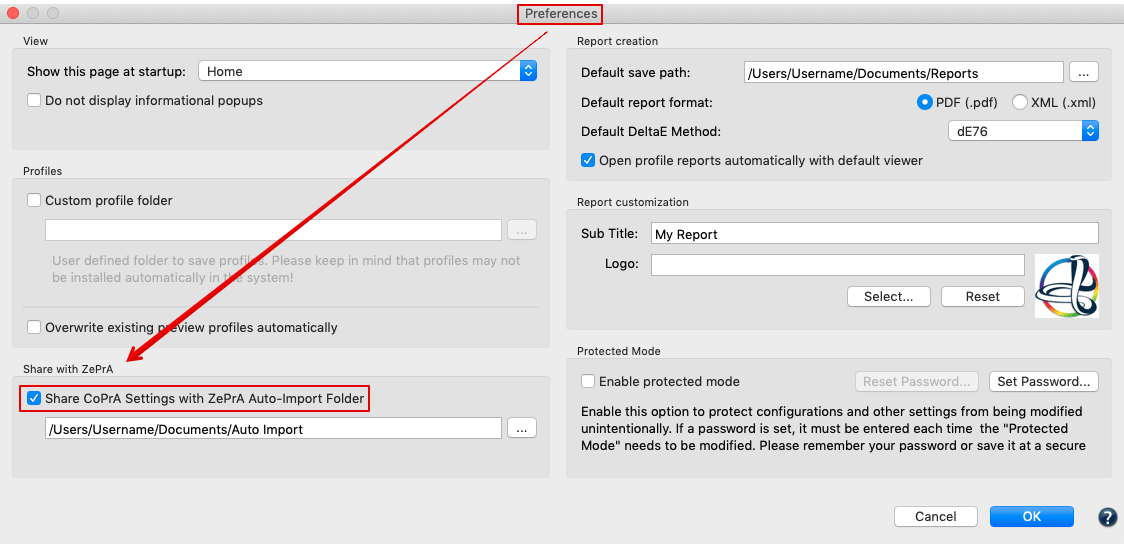
- In the DeviceLink tool, define all required settings by entering all relevant information under Rendering, Exceptions and Color Generation.
- Click Save As and enter a name for the setting. Confirm with OK, then activate the Share with ZePrA checkbox.

- CoPrA Settings created that way and shared with ZePrA are available for selection as SmartLink Method in the drop-down menus of both the Auto Setup and the Configurations settings.
Note: Only saved settings can be shared with ZePrA. Default or edited presets cannot be shared.
In ZePrA
Make sure to enable the Auto Import function in ZePrA’s Preferences and to use the same folder as CoPrA. CoPrA’s DeviceLink and SaveInk settings are now accessible in ZePrA and can be used there as a SmartLink Method. SmartLink can now create custom DeviceLinks which can be used in ZePrA configurations.
ZePrA’s Auto Import Folder
Files (such as ICC profiles, configurations, spot color libraries, gradations or SmartLink settings) that are moved or copied into the Auto Import folder are transferred to ZePrA’s internal dataset and can then be used by ZePrA.
When the file in the Auto Import folder is replaced by a newer version, it will be updated in ZePrA’s internal datasets as well.
Note: If a file in the Auto Import folder is deleted, it is not deleted in ZePrA’s internal dataset. For example if a SmartLink setting has been deleted in the Auto Import folder, it is still available in ZePrA’s internal dataset and if this setting is deleted in ZePrA’s dataset, it is still available in the Auto Import folder.
Rendering
Rendering - Overview
Every DeviceLink profile contains exactly one rendering intent. In addition to the standard rendering intents – Perceptual, Relative Colorimetric, Saturation, and Absolute Colorimetric – CoPrA offers six additional rendering intents.
Any two rendering options can be merged using a Merge slider to combine the best of both renderings. In addition, Chroma, Saturation, Lightness and the Gray Balance can be customized for all rendering intents as well. All this allows to individually adjust the rendering for a specific application.

Note: Merging rendering intents is recommended among Relative Colorimetric, Absolute Colorimetric, Blackpoint Compensation and any ColorLogic rendering intent. However, merging of Perceptual rendering and other rendering intents is not recommended for 3rd party profiles.
Gamut plot
The gamut plot illustrates a source and target gamut based on the selected Rendering settings for creating the DeviceLink profile. It is a graphical visualization of two virtual profiles with different white points and different gray balances. The source gamut white point and gray balance are assumed to be neutral in Lab and the target gamut to be a larger gamut with yellowish paper tint and yellowish gray balance. This can be seen if the Absolute Colorimetric rendering setting has been selected.
Note: The gamut plots are not based on the loaded profiles.
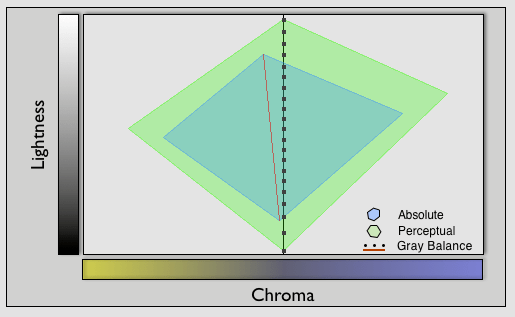
The plot of the Target Gamut does not change but the plot of the Source Gamut changes depending on the chosen Rendering method. If any other rendering setting than Absolute Colorimetric is selected, the white point of the source profile is matched to that of the target profile. The dotted line represents the gray balance of the Source gamut and it depends on the selected Rendering method. If a simple Relative Colorimetric rendering is selected the white points are matching but the black points are not and the gray balance is relative to the paper tint, e.g. yellowish.
For the Perceptual Rendering, there is a choice of paper-relative options such as Perceptual, Standard Compression, Blackpoint Compensation or Minimum Compression (Paper relative), or paper-absolute options such as Absolute Compression, Minimum Compression (Paper absolute) and Minimum White Compression. With all perceptual methods the white and black points are merged and synchronized between the two profiles. With paper-relative perceptual methods the gray balance is yellowish while it converges to the gray balance of the source gamut with paper-absolute perceptual methods. In our plot, for example, it is neutral.
A special feature of CoPrA’s DeviceLink module is the ability to Merge between two different rendering methods, for example, Standard Compression and Absolute Compression. The dotted lines of the gray balance and the shapes of the gamut indicate the effects when using the Merge slider.
Changes in the Advanced Rendering Options such as Saturation, Chroma, Lightness or the Gray Balance are also visible in the gamut plot. More Chroma results in a larger Source gamut and a cooler Gray Balance causes the dotted line to shift to the right to more bluish.
DeviceLink Rendering Intents
One of the most important decisions when creating a DeviceLink profile is to choose the optimal rendering settings for a given task. To simplify this decision, the Mode drop-down menu offers three modes for typical use cases in addition to a Custom mode.

Mode: Select between the following three typical use cases or select the Custom mode:
- Close Match: A typical use case is for achieving the closest possible match between two color spaces, e.g. to achieve a match similar to a proof but without paper simulation and avoiding washed out shadows. An example would be the reproduction of ISO coated V2 on a digital printing machine so that both prints should look the same.
- Automatic Paper Relative: A paper relative rendering without consideration of the paper tone. A typical use case would be a rather more colorful but still faithful rendering of a color space on a different printer. For example, a campaign prepared for ISO coated V2 but rendered on a large format inkjet printer without consideration of the paper tone.
- Automatic Paper Absolute: A paper absolute rendering with consideration of the paper tone. A typical use case would be the same as for Automatic Paper Relative, but with consideration of the paper tone.
- Custom: Gives full control to the user, enabling him to define all settings himself.
The first three Rendering modes Automatic Paper Relative, Automatic Paper Absolute and Close Match automatically calculate the best of two rendering methods considering Merge, Lightness and Chroma adjustments. The two drop-down menus for the rendering methods are then pre-selected with all the required options, e.g. the most suitable setting for the Merge slider as well as the best settings for the Advanced Rendering Options such as Lightness and/or Chroma. All these options are grayed out, they can only be changed if the Custom mode is selected.
Note: The Rendering modes Automatic Paper Relative and Automatic Paper Absolute support different gamut sizes, e.g. small to large gamuts, large to small gamuts and similar sized gamuts.
For the mode Close Match, the automatic calculation works best if the target color space has a larger or similar gamut as the source profile.
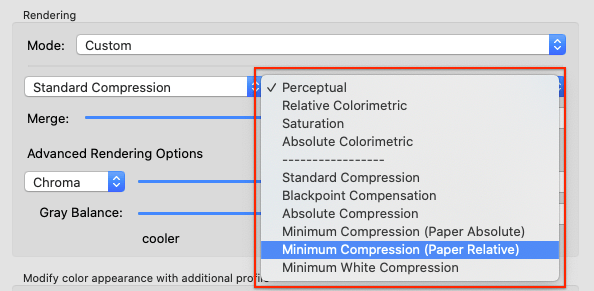
CoPrA’s DeviceLink Rendering Intents
Standard Compression: This is the default method. It uses a perceptual conversion that is well suited for all types of gamuts, i.e., also for conversions between color spaces of different sizes. Neutral tones are converted using a relative colorimetric approach, and the appearance of the gray axis always depends on the paper white of the target profile. Therefore, the gray axis of the transformed file will appear yellowish on a very yellowish paper. The same gray axis will appear bluish on a bluish paper. For very small color gamuts, for example in newspaper printing, the dark tones are raised slightly to achieve more image definition in these areas.
Black Point Compensation: Use Black Point Compensation to achieve the same results with a perceptive conversion as with “Relative Colorimetric with Black Point Compensation”. When converting from large to small color spaces, the image definition is preserved in the highlights and shadows, unlike with a pure Relative Colorimetric conversion. Neutral tones are converted using the Relative Colorimetric intent. Out-of-gamut colors are cut off.
Absolute Compression: This method is based on the absolute colorimetric rendering intent in terms of color reproduction and is recommended when the paper tones differ significantly (the color gamuts can be similar or different). In contrast to the Standard Compression and Black Point Compensation, the paper tint is compensated in the gray balance. The rendering of neutral colors is based on the absolute colorimetric rendering intent, without paper tone simulation in the highlights. If, for example, the paper white is significantly more yellow than in the reference, the gray axis appears neutral despite the yellowish paper tone. This ensures that the color appearance of the original file is preserved as best as possible on a target medium with a different paper tint. The contrast range in the highlights and shadows is adapted to avoid any loss of image definition.
Dynamic Compression: Only available in CoPrA 6 and lower. Compares the source color space with the target color space and generates a compression that minimizes out-of-gamut areas. This setting preserves the brightness of the original color space while reducing the saturation, and therefore also preserves the image definition. As for the Standard Compression, the gray axis of the conversion is built relative to the paper white of the target profile. This approach is well suited when the source and target profiles have a very large dynamic range and contrast, for example, in RGB-to-CMYK conversions.
Note: This method is now only available in ZePrA for compatibility reasons, and no longer in CoPrA. We recommend using Automatic Paper Relative instead.
Minimum Compression (Paper Absolute): This method is largely similar to the absolute colorimetric intent and only compensates close to the black and the white point.
In addition, the white point of the source color space is not simulated, but scaled to the white point of the target color space, thus ensuring a pure paper white.
Use this rendering intent to achieve a close reproduction, for example when using print standards such as ISO Coated V2 or GRACoL2006 Coated1v2 on a digital printer.
Note: As for the absolute colorimetric rendering intent, ensure that the target color space is larger or has at least a similar size to avoid any loss of image definition. For color conversions from larger to smaller color spaces use Absolute Compression to maintain the gray balance of the source color space.
Minimum Compression (Paper Relative): This method is largely similar to the relative colorimetric intent and only compensates close to the black and the white point. It is similar to Minimal Compression (Paper Absolute) but uses relative colorimetric instead.
Minimum White Compression: This method is similar to Minimum Compression (Paper Absolute). Both rendering intents compress the white point without paper simulation, however, there is an important difference: The Minimum Compression is a rather perceptual rendering that additionally compresses the black point, so the maximum dynamic range is utilized without loss of detail in the shadows. In contrast, the Minimum White Compression compresses the white point but not the black point, so a close absolute colorimetric match between source and target color spaces can be achieved. This can be useful for the color representation across various media, color matching or printing on slightly differing media. It can be regarded as close to absolute colorimetric rendering without paper tint simulation.
Note: Remember that the target color space should be larger than the simulated color space (or similarly large) to avoid loss of detail and vividness (similar to the absolute colorimetric rendering intent). For conversions from large to small color spaces, instead use our rendering intent Absolute Compression if the gray balance of the source color space is to be preserved.
Additional Options
Merge: Use two rendering methods, merge them in defined proportions when creating the DeviceLink profile. For instance, choose the combination Standard Compression (1st selection, left) and Absolute Compression (2nd selection, right) and set the Merge slider to 75, the corresponding proportions of the two rendering methods are used in the DeviceLink profile when converting files. In this example, 75% Absolute Compression and 25% Standard Compression results in a gray axis that is 75% adapted to the paper color, without paper color simulation in the highlights and a simultaneous adaptation of the contrast range in the highlights and shadows.
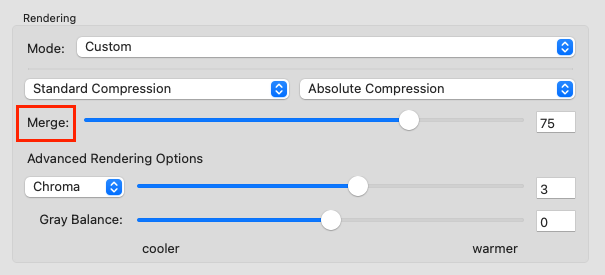
Advanced Rendering Options
Advanced Rendering Options: The drop down menu allows changes to the overall Chroma, Lightness or Saturation of the profile using a slider.
Chroma can be used to reduce or increase the chroma of highly saturated colors in the range between -20 and +20.
Saturation can be used when highly saturated colors are required. As with Chroma, the gray balance is not affected when moving the slider. Saturation or Chroma can be used especially for large color spaces such as gamut extending Multicolor in order to achieve more brilliant colors.
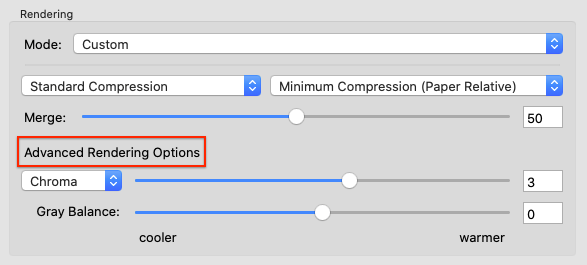
Advanced Rendering Options
Notes:
- ColorLogic intentionally keeps the chroma effect moderate. However, when increasing the chroma, ensure that the setting neither causes a loss of image definition in highly saturated colors or adversely affects colors such as skin tones.
- The effect of each of these settings is shown in the gamut graph on the right. Increasing the saturation results in higher chroma and lower lightness, so more saturation will slightly darken the colors and they will appear more vibrant. In contrast, more chroma can result in high chroma colors being out-of-gamut and these colors would not be rendered by the given profile.
Gray Balance: Allows adjustment of the gray balance to create a cooler or warmer gray axis. cooler shifts the gray balance towards more bluish colors (negative b* values), warmer shifts it towards yellowish colors (positive b* values). The effect of the slider setting is visualized in the graphic.

Changing the Gray Balance
Note: The setting Gray Balance works independently from the selected Rendering method which has already an effect on the gray balance and allows visual adjustments based on personal color preferences.
Modify Color Appearance with Additional Profile
Modify Color Appearance with Additional Profile: Incorporate a correction into a DeviceLink profile by using an additional profile, such as an edited DeviceLink or an abstract profile. The additional profile may contain a selective color correction in a certain color range or specify a change in the gradation tonalities. The additional profile will be included in the calculation after the source profile is linked to the target profile.
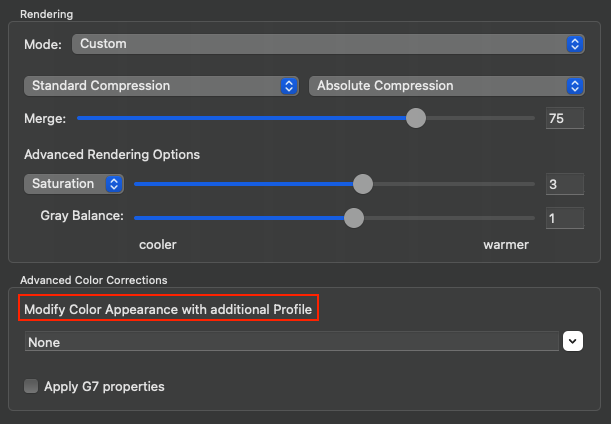
The Modify color appearance with additional profile represents special situations, therefore the setting None should be selected in most cases.
Note: Further information about the creation of edited profiles can be found in the section DeviceLink Editing.
Apply G7® properties: When using a source profile that complies with a certain standard (e.g., the G7® method), this property may be lost or changed when converting to a target profile.
Apply G7 properties adds a correction so that the DeviceLink conversion complies to the G7® method.

Note: This option is not limited to G7® based source profiles and will add the correction to any DeviceLink conversion when enabled.
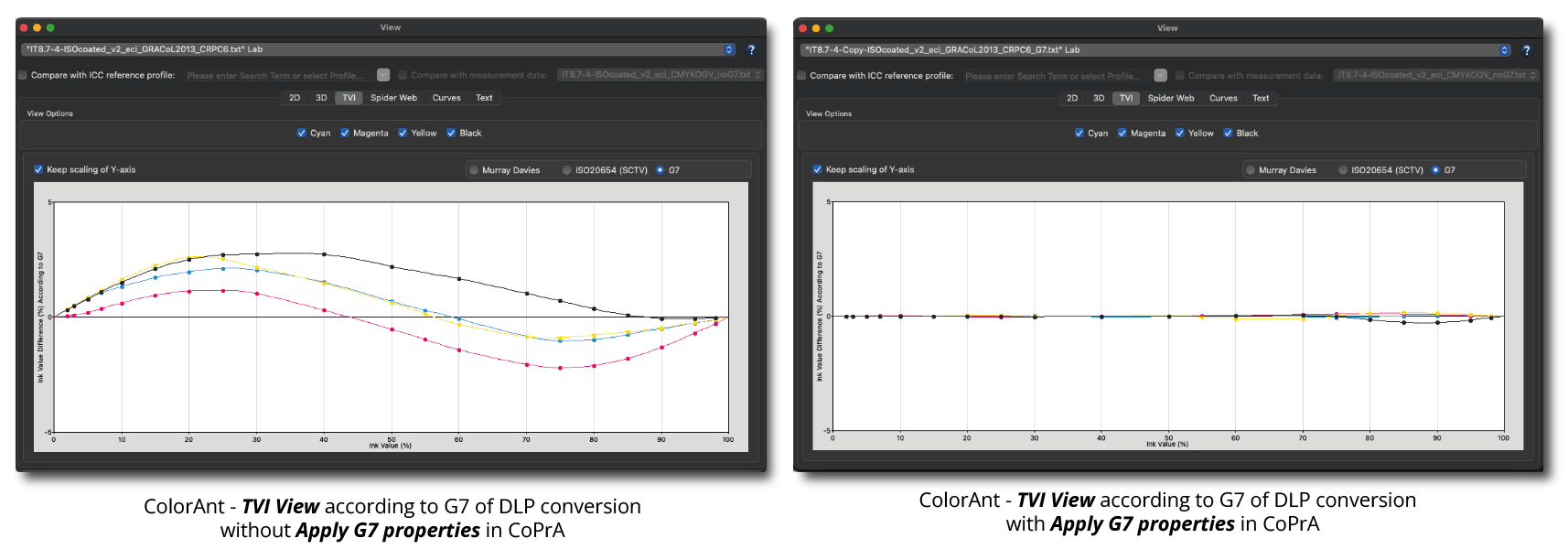
Note: The Apply G7 properties option is also included in the Profile Report.
Exceptions
Automatic Exceptions
The proper choice of exceptions in DeviceLink profiling can sometimes be an art in itself and ensures hue-accurate, pure and saturated colors as well as print optimized color behavior, for example when overprinting. In order to facilitate this choice, the tab Exceptions contains an option for the automatic selection of the most appropriate exceptions for the selected source and target profiles. Here, different kinds of calculations for color rendering, color distances, device color differences as well as empirical values regarding the preservation of color purity will be combined.
To activate this function, select the mode Automatic. After a short calculation time recommended exceptions are either enabled or disabled. All automatically identified exceptions are grayed out. Exceptions that are not implicated are not grayed out and can be activated or deactivated manually. This makes it much easier to choose exceptions appropriately.

Note: We recommend enabling the automatic selection of exceptions for the creation of DeviceLinks by default in order to obtain a good preselection. If you prefer to select exceptions manually or if you would like to adjust the automatically determined settings, select the mode Custom. If you have manually selected exceptions or a DeviceLink preset and then switch to Automatic, previous settings will be overwritten.
Custom Exceptions
Exceptions are used to specifically influence color conversions of special colors. If source and target colors in a color conversion are identical the colors will be linearized. If the color spaces differ, the colors will be optimized and adapted.
Exceptions ensure that special properties of colors remain unchanged. The choice of appropriate Exceptions thus allows a precise color conversion of specific colors. Exceptions preserve the properties of the input colors (for example using a single color channel for primary colors or two color channels for secondary colors) and calculate the best possible combination to minimize related color errors (our definition of “optimized”).
All color patches that are affected by the selected exception are highlighted in the graphical representation by a red border. If you move the mouse pointer over a color patch it is emphasized by a black or white border and the values of the source and target color space are displayed. Press the “Alt” key on your keyboard to capture the color patch allowing you to check quickly and easily whether it is affected by an exception.
Exceptions which are not available are grayed out. This may be the case when a dependency between exceptions exists, or when exceptions are not relevant for a specific color space.
Exceptions are often related to each other under certain circumstances such as Rendering or Black Generation settings. For example, if the Gray exception is enabled the 100% Black exception is enabled automatically, too. However, this is only the case if a perceptual rendering method has been selected. If a relative or absolute colorimetric rendering method has been selected these two exceptions are independent because in these cases we want to respect the colorimetric accuracy.
Custom Exception settings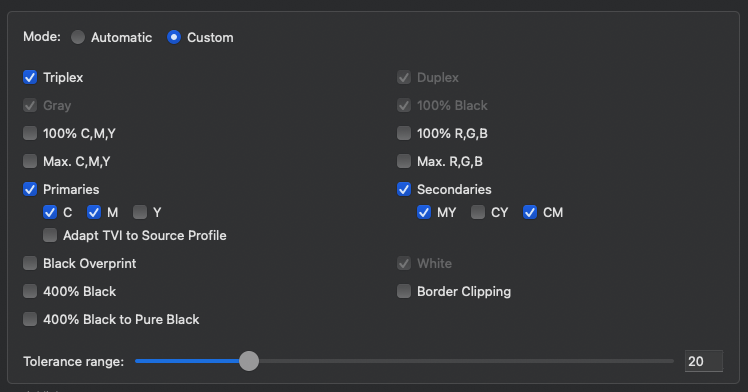
Triplex (two primary colors plus black): Optimizes the color conversion of a secondary color (for example, blue: cyan plus magenta) plus black by preventing color contaminations. Triplex colors are recalculated during the conversion but remain triplex colors in the target profile. Therefore, if you have a dark shade of blue, like 100C 60M 50K, and you would like to convert it to the most suitable blue represented in the target color space consisting only of cyan, magenta and black, the exception Triplex must be activated.
The exception Triplex includes the exception Duplex and therefore also the exceptions Primaries, Secondaries, Gray and 100% Black.
Duplex (a primary color plus black): Optimizes the color conversion of a primary color (cyan, magenta or yellow) plus black by preventing color contaminations. Duplex colors are recalculated during the conversion but remain duplex colors in the target profile.
The exception Duplex includes the exceptions Primaries, Gray and 100% Black.
Gray: Protects the single-color structure of Black from 0 to 100%. This exception includes the exceptions 100% Black and White.
For RGB DeviceLink profiles Gray ensures that the gray axis is composed of equal RGB value proportions. For a conversion of an RGB source profile into a CMYK target color space, Gray ensures that the RGB gray axis is created by black only.
100% Black: Protects 100% black, so 100% K remains 100% K and will not be supplemented with or replaced by CMY.
For a conversion of an RGB source profile into a CMYK target color space 100% Black ensures that an RGB black of 0, 0, 0 is converted to 100% black. For example, this allows you to prevent a pure black RGB text from being composed of four colors in the CMYK profile after the conversion.
100% C,M,Y: Protects cyan, magenta and yellow. The 100% values of C, M and Y are retained after the color conversion at 100%.
100% R,G,B: Protects pure red, green and blue. The 100% values of red, green and blue are retained after the color conversion at 100%. Red will therefore still be formed with 100% magenta and 100% yellow.
Max. C,M,Y: Creates a maximum saturation of primaries. This function can be used independently of the protection of primaries and secondaries.
Example: If 100C would be converted to 80C + M + Y, activation of this exception ensures that cyan is now converted to the maximum value, which means, C is set to a value higher than 80, i.e. a value between 80C and 100C, depending on what is achievable in terms of maximum saturation while contaminating color proportions are adjusted color corrected.
Note: If the exception Primaries is selected as well, the exception Max. C,M,Y is grayed out while the exception 100% C,M,Y is activated instead, as in the case of a purity protection of primaries the maximum value is 100%.
Max. R,G,B: In CMYK color spaces ‘R, G, B’ corresponds to the color combinations MY, CY and CM. When activated, the higher color value is set to 100% while the second color value is optimized colorimetrically. This function can be used independently of the protection of primaries and secondaries.
Example: If a pure 100% red (100% M+Y) would be converted to 95% M and 90% Y in a conversion with pure secondary colors, activating the setting Max. R,G,B increases the color red to maximum saturation, like 100% M and 95% Y. However, if you require that 100% red remains 100% red in the conversion, use the setting 100% R,G,B.
Note, however, that this might not be the best colorimetric value. Max R,G,B, on the other hand, calculates the best color correct value with the highest level of saturation.
Primaries: Protects the single color structure of primary colors. Calculates the Lab value of a primary color of the source profile and searches for the best matching primary color value in the target profile. For example, 40C might be converted to 53C but the single color structure remains. If this exception is not enabled, primary colors of the source profile may be contaminated in the target profile. The checkboxes C, M and Y allow protection of individual primaries. Here, optimized transitions are calculated which gently extend into adjacent color areas in order to avoid hard edges. The slider Tolerance range defines how far adjacent color areas are included.
Note: Enabling this exception does not preserve the 100% values which means that 100C might be converted to 98C. If you would like to conserve the 100% values in the target profile, enable the exception 100% C,M,Y.
In case of a conversion of an RGB source profile into a CMYK target color space, Primaries ensures that the primary colors C, M and Y are kept pure.
Adapt TVI to source profile: This exception is important when tone value increases of primary colors needs to be preserved precisely. An application example would be a predefined printing standard that needs to be printed on a different paper while the used target profile featured a different tone value increase. The exception Adapt TVI to source profile allows creation of a DeviceLink profile which corrects the tone value increases of the target profile to meet the requirements of the printing standard (from the source profile) precisely.
Secondaries: Protects the two-color structure of secondaries. Calculates the Lab value of a secondary color of the source profile and searches for the best matching secondary color value in the target profile. For example, 40C 100M might be converted to 41C 97M but the two-color structure remains. If this exception is not enabled, secondary colors of the source profile may be contaminated in the target profile. The checkboxes MY, CY and CM allow protection of individual secondaries. Here, optimized transitions are calculated which gently extend into adjacent color areas in order to avoid hard edges. The slider Tolerance range defines how far adjacent color areas are included.
In case of a conversion of an RGB source profile into a CMYK target color space, Secondaries ensures that the secondary colors MY, CY and CM are kept pure.
Black overprint: Protects 100% black as additional layer above a CMY background: CMY values are minimized but colors are calculated correctly and changed as little as possible compared to the original.
White: Protects the paper white. This is especially useful when you would like to achieve an absolute colorimetric simulation for proofs without a simulation of the paper color (e.g. for aesthetic reasons). Is available only if Absolute Colorimetric is selected as Rendering intent and Proofing as a Setting.
400% Black: Protects 400% Black: Even when a lower Total Amount of Color (TAC) is selected in the tab Color Generation, a color value of CMYK = 100%, 100%, 100%, 100% is maintained.
Border Clipping: Percentage values close to zero will be set to 0% and key values close to 100% will be rounded up to 100%. This results in pure tones which no longer need to be screened in printing.
400% Black to Pure Black: 400% inks will be converted to 100% black, so CMYK = 100%, 100%, 100%, 100% will be converted to CMYK =0%, 0%, 0%, 100%.
Tolerance range: This slider defines how far the exceptions affect neighboring color combinations. This allows smoother transitions between patches that have an exception assigned to them and adjacent patches. The Tolerance range has a non-linear effect.
Highlights

These settings specify when the First Printed Tone in the profile is recognized and appears in the proof (hard or soft proof) or how high the tone value prints at 1%. This ensures that your proof matches your printout. Analogically, when a profile is used for separation which was created with a value of 3% for the first printed tone, small tonal values will be raised to 3% to be printed reliably. By selecting a setting for the first printed tone you can determine whether the created DeviceLink is intended for Proof or Production.
Default: Ensures ‘normal’ profiling behavior in highlight areas. Use this setting for all printing processes that don’t require any adjustment of the first printed tone.
First Printed Tone (Production, Preserve 0%): The paper white remains unaffected. Small tonal values will be increased to the entered percentage to be printed more reliably. The purity of colors set in the tab Exceptions will be preserved. This may result in hard edges.
First Printed Tone (Proof): Use this setting to specify when the first printed tone will appear. For example, if you enter 3% for the first printed tone, no tonal values will be printed from 0 to 3%. Color values will start only from 3%.
Printed Tone at 1% (Proof): This setting defines the tone value to be reached at 1%. It is popular for proofing but can be used for production applications as well.
First Printed Tone (Production, Preserve White): The paper white remains unaffected. Low tones will be increased to the entered percentage throughout the separation to be printed more reliably. The settings defined in the tab Exceptions are not retained as a tone is composed using all channels. This reduces hard edges.
First Printed Tone (Production, Minimal Tone): The paper white will be replaced by the set tonal value in all channels throughout the separation.The settings defined in the tab Exceptions are not retained as a tone is composed using all channels. This reduces hard edges.
Dependency between Gray and White exceptions in Soft Proofs
When creating DeviceLink profiles using the rendering intent Absolute Colorimetric the simulation of the paper color will be prevented when the exception Gray is activated. The use of these exceptions in combination with the rendering intent Absolute Colorimetric is contradictory and therefore not recommended.
For this reason, all exceptions are disabled by default when the setting Proofing is selected in CoPrA. In order to make this dependency even clearer, the exceptions White and Gray are linked to each other. When an exception which is connected to Gray (e.g. Duplex or Triplex) is activated, the exception White will be disabled and grayed out automatically.
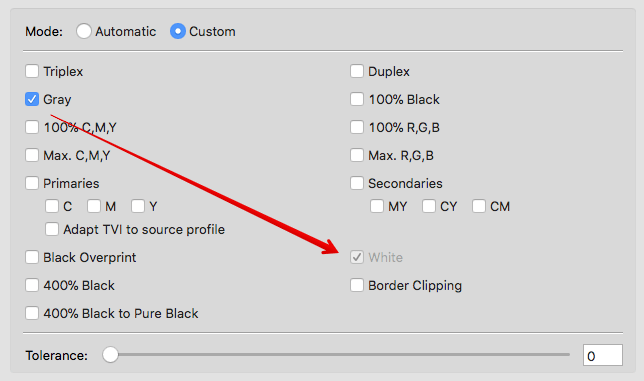
Note: Please note that the exception White is only available when Absolute Colorimetric is selected as Rendering intent. The exception White ensures that paper white is not simulated which is especially useful when trying to achieve an absolute colorimetric simulation for proofs without a simulation of the paper color (e.g. for aesthetic reasons).
Color Generation
Color Generation
Multicolor Mode: Determines how colors will be built up in individual separations. Is only available when a Multicolor target profile has been loaded. A Multicolor license is required to use Multicolor features.
Note: Multicolor modes that are not recommended for the loaded measurement data are marked red in the drop-down menu.
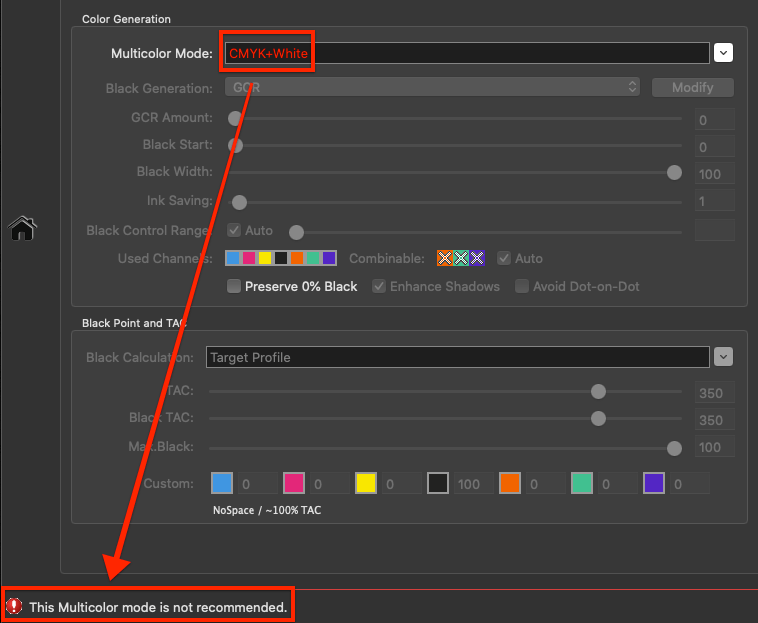
In some cases a warning or information message is shown below at the bottom of the window in case the loaded data may require a different mode than the selected one.
In CoPrA, the first three channels represent primary colors (usually CMY). They should form a sound color space (gamut) and should also be able to create a gray axis. The fourth channel should be black if a separation with UCR/GCR is desired. If black is absent in the Multicolor measurement data while automatic Black Calculation is selected, it will be recognized by CoPrA and the separation will not be generated. Black separation is disabled if the value for Max. Black in the Black Point and TAC setting is 0%. Additional spot color channels (e.g. Orange, Green or Violet in a CMYK-OGV 7 color data set) are regarded as color space expanding colors. The Multicolor Mode determines how color space expanding colors are factored in together with primary colors.
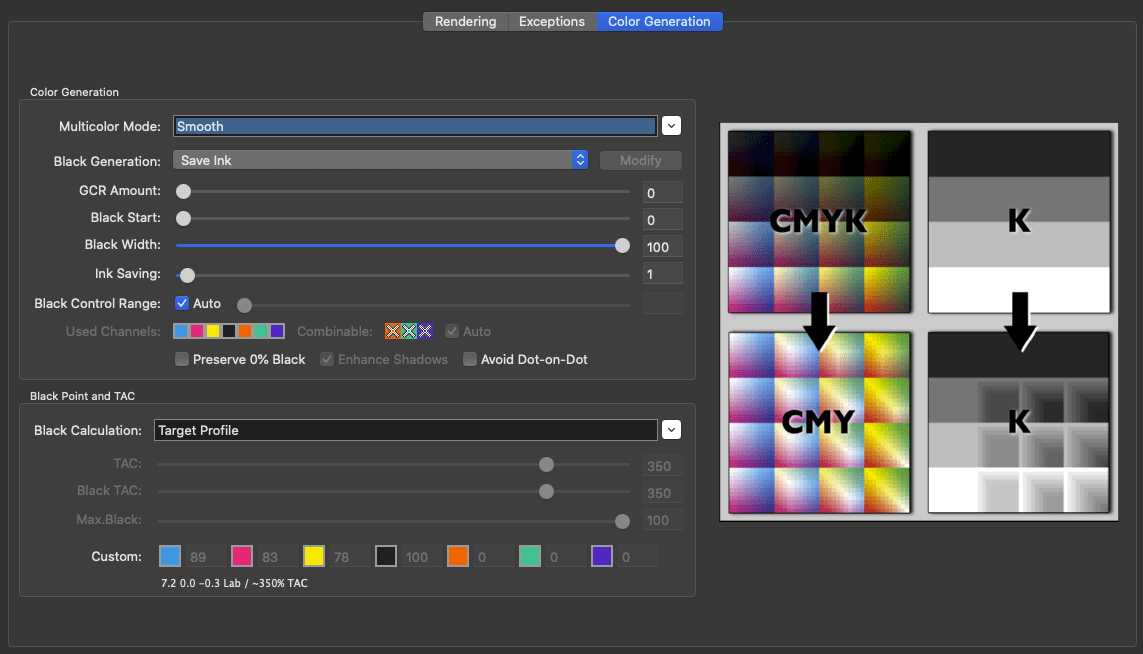
The following Mulicolor modes are available:
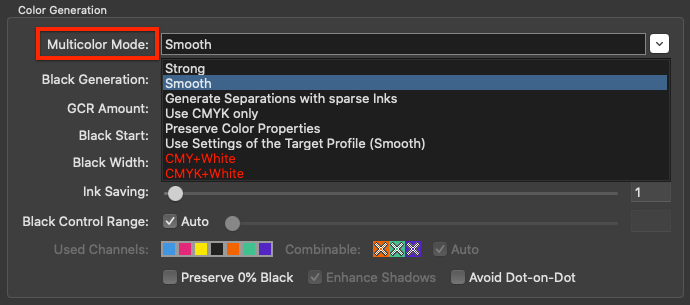
Strong: As much spot color as possible will be applied. Accordingly, fewer primaries will be used in the highly saturated color areas. This results in a greater use of color space expanding spot colors and therefore in highly saturated colors in the printout.
Smooth: Use this method when more CMY is required and if a particularly smooth and harmonious separation with the extended colors is needed.
Note: The two Multicolor modes Smooth and Strong are similar but Smooth uses less color space expanding spot color channels.
Generate separations with sparse inks: Is of interest for the packaging market as color separations are created in such a way that a certain hue uses as much as possible of a related spot color and very little or no primary colors. For example, in order to create a red color as much as possible of a reddish spot color is used but very little to no magenta or yellow. A maximum of two or three colors are used for each color segment and, therefore, this Multicolor mode is practical to save process colors. However, black generation cannot be controlled and is based on the (separation) mode MaxK.
Note: In contrast to the Multicolor modes Smooth, Strong and Use CMYK only, the Multicolor mode Generate separations with sparse inks does not allow regulation of the Black Generation. Accordingly, these settings are grayed out.
Use CMYK only: Selecting this method results in a Multicolor DeviceLink profile that creates the desired number of channels (e.g. 7 channels) but is only composed of CMYK. The color space expanding spot color channels are not used for the separation.
Notes:
- In package printing there is sometimes a request for images and vectors composed of CMYK to be generated with only minimal changes to CMYK values and without spot colors – despite conversion into a Multicolor space. In this case, only spot colors, like Pantone colors, which are present as DeviceN in the PDF should be converted into the large Multicolor space. Such a workflow is possible in two easy steps: (1) Creation of a separation-preserving CMYK-to-Multicolor DeviceLink profile in CoPrA using the Multicolor method Use CMYK only. (2) Spot color conversion of the PDF using ColorLogic’s color server ZePrA.
- In CoPrA all setting concerning the Color Generation (i.e. the entire tab) depend on black being present in the measurement data. This also applies for Exceptions. All Exceptions concerning black (Gray, Black, Duplex, Triplex, Black overprint) use black as fourth channel, therefore, black must be present in the measurement data or ICC profiles as fourth channel. If black is not present in the measurement data as fourth channel, this channel will be treated as if it were the black channel.
As an example, if blue is present as fourth channel, then all settings in the tabs Color Generation and Exceptions will still treat the fourth – now blue – channel as black channel. In this situation, spot colors can be used for the calculation of the gray balance and the black point.
Preserve Color Properties: Is only available for Multicolor-to-Multicolor DeviceLink profiles. This Multicolor Mode allows the use of Exceptions for all Multicolor channels (not only for CMYK) thus preserving pure colors and the separation characteristics of the source.
All types of Multicolor-to-Multicolor combinations can be applied. Source and target color spaces can differ in their number of channels (e.g. for 6 to 7 color DeviceLinks), in their hue, or in their name.
Channels that are similar in hue are automatically assigned even if the channel names or the channel order differ between source and target profiles. If single channels do not match between source and target profiles but other channels do, the matching channels will be retained while the non-matching channels are recalculated using a mixture of the other channels to match the colors of the original channel.
Example: When combining a CMYKOB profile with a CMYKOGV profile, the Orange channel (O) will be retained but the Blue channel (B) will be recalculated using Violet (V) and a mixture of the other primaries to match the Blue original colors.
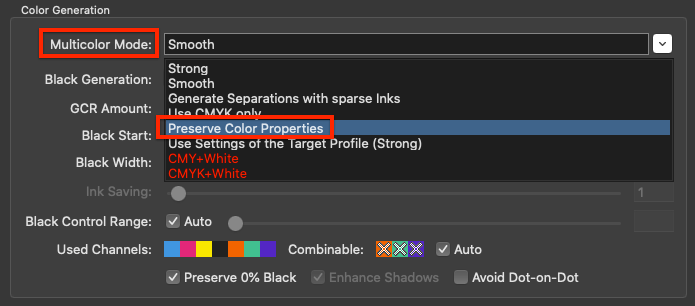
Note: Exceptions for Primaries affect all channels. The exceptions for Secondaries keeps all two color combinations pure, not only those with CMY portions.
Use Settings of the Target Profile: Uses the Multicolor mode that was selected when the printer profile was created. The used mode is written in parentheses. That way it is immediately clear which mode was used in the profile.
Note: Only applies to CoPrA printer profiles. For non CoPrA Multicolor profiles the Strong Multicolor mode will be used.
CMY+White: If the measurement data includes White as a color channel in addition to 3 primary colors, Multicolor Mode must be selected. CMY refers to any 3 primary colors that form a sound color space and include a gray balance. This mode predefines the separation settings to use the color of the background (e.g. the black substrate) and the white ink within the separation. It automatically selects the optimal settings, therefore, all other Color Generation controls are disabled, only the overall TAC can be adjusted under Black Point and TAC.
Please be aware that the resulting ICC profile is a Multicolor profile (4CLR profile).
CMYK+White: If the measurement data includes White as a color channel in addition to Black and 3 primary colors, this Multicolor Mode must be selected. CMY refers to any 3 primary colors that form a sound color space and include a gray balance. This mode predefines the separation settings to use the color of the background (e.g. the black substrate) and the white ink within the separation. It automatically selects the optimal settings, therefore, all other Color Generation controls are disabled, only the overall TAC can be adjusted under Black Point and TAC. The assumed black point, e.g. the darkest color, uses a predefined combination of 100% Black printed on the back substrate.
Please be aware that the resulting ICC profile is a Multicolor profile (5CLR profile).
Background: For color managed color prints on black substrates, such as textiles, white ink must be used first and colors must be applied on top of the white ink to obtain colorful graphics.
Note: To create profiles with White, special test charts are required, which can be found in the test charts subfolder Special for the two cases CMY+White_on_Black and CMYK+White_on_Black.
Black Generation
Defines the method for the generation of black in the target color space and therefore influences the separation comprehensively. Nine different black generation modes are available in the drop-down menu (depending on the licensed modules):
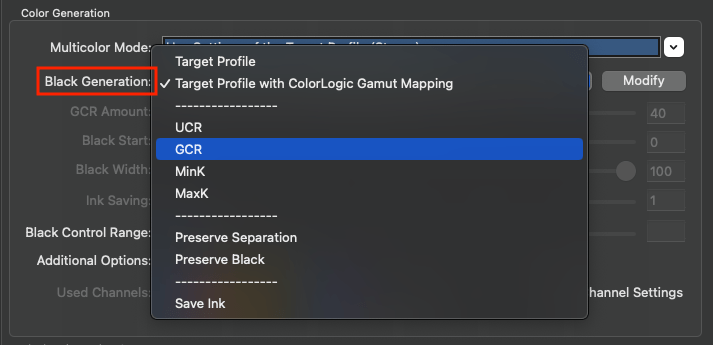
Target Profile: Uses the black separation and the out-of-gamut mapping of the target profile. Denies modifying the Color Generation and Black Point and TAC settings.
Target Profile with ColorLogic Gamut Mapping: Uses the black separation of the target profile – same as Target Profile – but recalculates the out-of-gamut mapping. Allows to change the Black Point and TAC settings. After clicking Modify the black generation settings can be changed as well. This way the settings of the target profile act as a starting point and can then be adapted to your needs.
Note: When clicking Modify the black generation switches to an appropriate mode closest to the target profiles settings (GCR, UCR, maxK…). This works best for ColorLogic printer profiles as the appropriate settings are exactly reproducible. For 3rd party profiles this may lead to a little update of the curves as with some profiles only settings as close as possible to those of the 3rd party profile will be found.
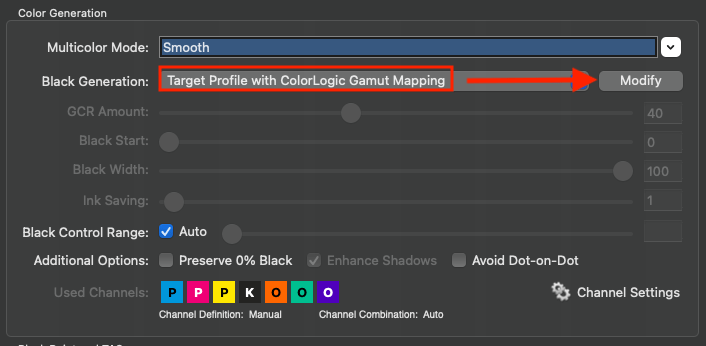
UCR: Allows adjustment of the settings Black Start and Black Width.
GCR: Additionally allows the adjustment of the setting GCR Amount.
MinK: Only uses a minimal amount of black and generates a separation using the maximum amount of CMY.
MaxK: Uses a maximal amount of black and generates a separation using the minimum amount of CMY. Is only available with a SaveInk license.
The methods UCR, GCR, MinK and MaxK generate a new separation, regardless of the separation of the target profile.
Preserve Separation: Preserves the ratio between the black channel and CMY composed black.
Note: The black generation mode Preserve Separation is especially important for conversions between similar CMYK printing processes (conversions between two offset presses or two inkjets of the same model etc.), because it ensures that the ratio between CMY and black which is used to generate gray is maintained in the color conversion.
When the mode Preserve Separation is selected, Enhance Shadows should always be enabled.
Preserve Black: Linearizes the black value of the source profile and retains the black channel.
Save Ink: Replaces CMY colors by black to save CMY inks. This setting is only available with a SaveInk license.
Preserve 0% Black: Is available when selecting one of the Black Generation modes Target Profile with ColorLogic Gamut Mapping, GCR, UCR, Preserve Separation or Save Ink. It prevents the generation of black in separations for source colors without black. This is important for some overprint applications.
Note: In order to use this function for the Preserve Separation mode, the Enhance Shadows checkbox must be enabled.
Enhance Shadows: Is also only available when the mode Preserve Separation has been selected. Prevents detail losses in dark colors and weak shadows.
GCR Amount: Defines the amount of CMY that is replaced by black. At 0 only a low GCR amount is used which mainly impacts the shadows whereas at 100 a very strong GCR is used which affects the shadows and the highlights.
Black Start: Defines the starting point for the black generation. Black will be used if the minimum amount of C, M, Y exceeds this limit.
Black Width: Defines the range in which black is generated outside the color-neutral area. The lower the value the less black will be generated outside the color-neutral area.
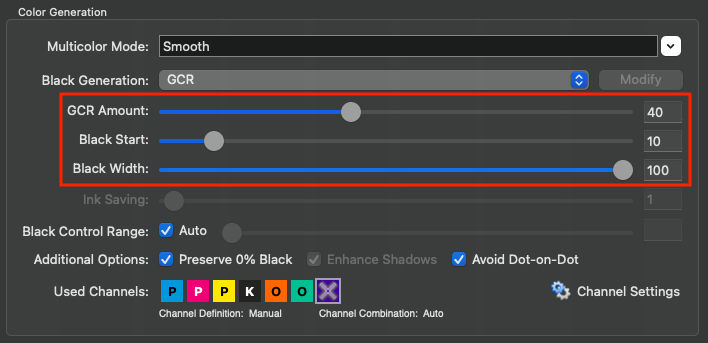
Ink-Saving: Replaces CMY colors by black to save CMY inks. This setting is only available with a SaveInk license (included in CoPrA XL and CoPrA XXL) and if the Save Ink option was selected under Black Generation.
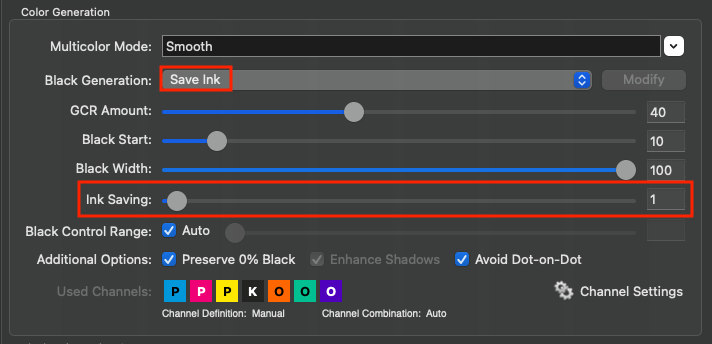
Black Control Range: Controls the transition to black. If black exceeds the limit, CMY colorants will not be modified and black is linearly added. Up to the specified value black will be calculated accurately. A value of 0% indicates that only CMY will be converted whereas black will be linearized. If a proof requires an exact colorimetric reproduction the slider should be set to 100%. 80% is a good value to achieve a smooth transition in the shadows. We recommend activating the checkbox Auto.
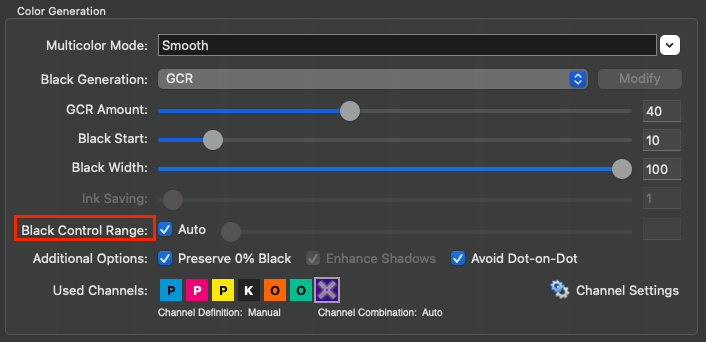
Additional Options
Preserve 0% Black: Is available when selecting one of the Black Generation modes Target Profile with ColorLogic Gamut Mapping, GCR, UCR, Preserve Separation or Save Ink. It prevents the generation of black in separations for source colors without black. This is important for some overprint applications.
Note: In order to use this function for the Preserve Separation mode, the Enhance Shadows checkbox must be enabled.
Enhance Shadows: Is also only available when the mode Preserve Separation has been selected. Prevents detail losses in dark colors and weak shadows.
Avoid Dot-on-Dot: Prevents Black and Violet/Blue color combinations that could produce dot-on-dot effects in AM printing. Replaces some of the Black by CMY, therefore avoiding dot-on-dot effects.
Background: When using gamut extending process colors in traditional AM screening, such as CMYK+Orange+Green+Violet/Blue, the process colors Violet or Blue are often on the same screening angle as Black which can cause dot-on-dot issues leading to color and lightness variances. However, avoiding Black and Violet/Blue color combinations in separations would reduce the available gamut considerably and would also prevent dark bluish spot colors from being reproduced faithfully. By activating this feature the separation uses more of the CMY colors instead of Black thereby preventing dot-on-dot effects. For this function to work best, use a late Black Start and a rather weak GCR or even a UCR Black Generation setting.
Note: Other color combinations using the same AM screening angles such as Cyan and Orange or Magenta and Green are not affected by this feature as those combinations are rarely used in separations anyway.
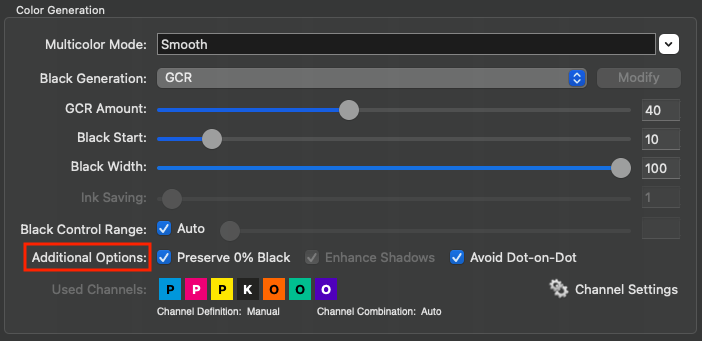
Used Channels: Displays the channels to be used in a profile. Excluded channels are grayed out and marked with an X. All settings that affect channels, such as channel definition, channel combination, or enabling/disabling channels, can be configured in the Channel Settings. This can be done both automatically and manually.
Note: If the Black Calculation is set to Target Profile, the black point is preset by the profile and the function Used Channels is deactivated.

The effect of selecting or excluding colors on Curves and the Gamut is immediately visualized in the graphic and the Black Point value.
Note: The excluding channels function is particularly intelligent for Multicolor profiles, as it searches for replacement colors in the Multicolor channels when excluding a channel (e.g., Cyan), which can compensate for the missing channel in the gray balance. The alternatively calculated Multicolor channels are displayed grayed out in the panel Black Point and TAC (further information can be found in the toggle Black Point and TAC).
Example: If a brown chocolate artwork is intended to be printed in CMYK without using any Cyan in the separation, a CMYK printer profile can be created which only uses MYK. These types of profiles avoid unwanted Cyan dots in the separation and the converted artwork would appear visually close to a conversion with a complete CMYK profile. Obviously such a profile should not be used if the artwork contains Cyan based color combinations, such as cyan tones and blue or violet colors.
Channel Settings: By default, all channels of the profile are enabled, and all Channel Settings are set to Auto. Channels can be enabled or disabled by clicking on the icon of the desired channel. It is possible to exclude multiple channels.
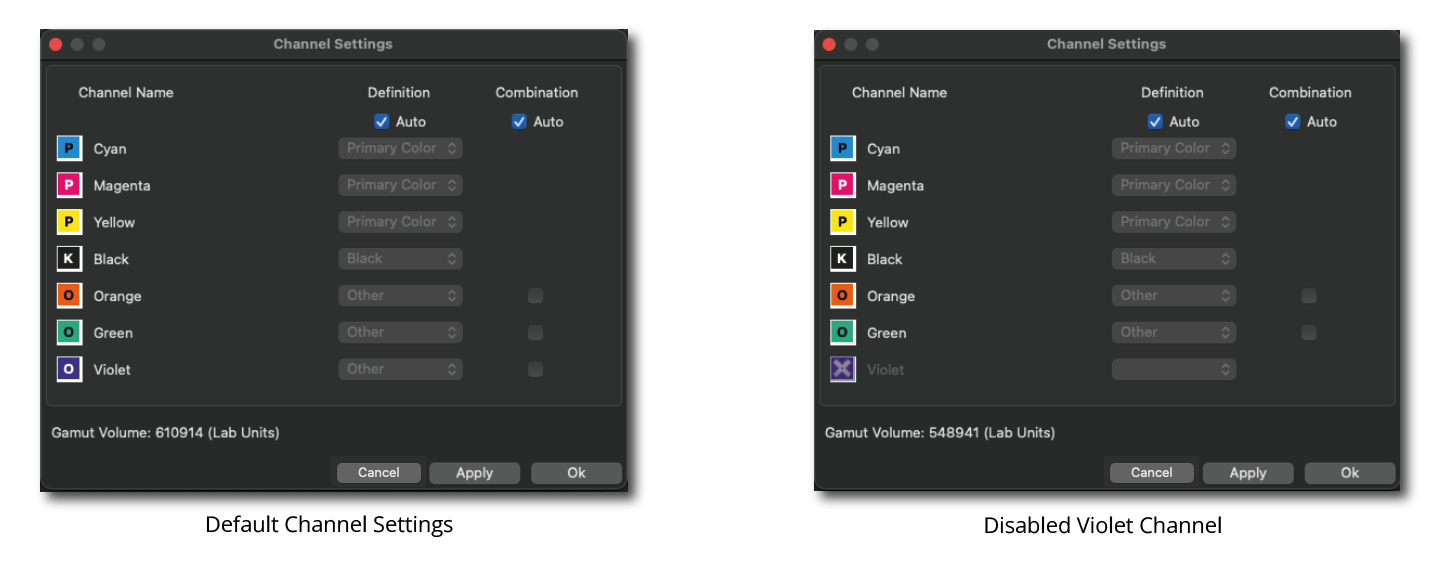
Note: In CoPrA, the default channel order in the measurement data has always been: Three primary colors (P), optional black (K) and optional additional (other) colors (O). This definition was applied regardless of whether the order could be handled correctly or not.

The Channel Settings option allows editing channels that are not defined in the correct order so that they can be used correctly in CoPrA.
Definition: The channel Definition determines the assignment of the channels, i.e., whether it is a Primary Color (e.g., CMY), Black or another gamut-extending (spot) color (Other). This assignment can be done automatically or manually. By default, the order is set automatically (Auto).
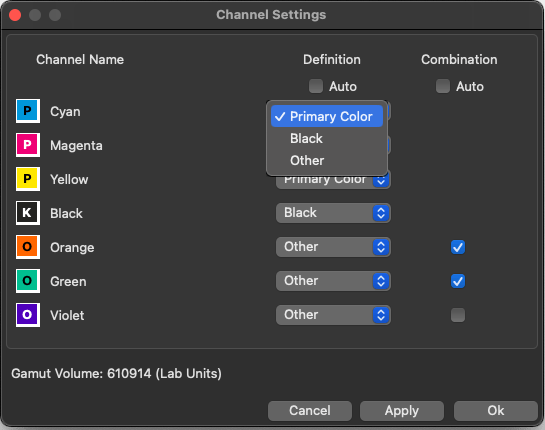
An important element of the channel Definition is the inherent flexibility to achieve the maximum gamut volume from the measurement data used.
Note: There are several reasons why measurement data do not comply with the required printing sequence.
For example, in some applications, a specific color sequence must be adhered to on printing presses, and the RIP assigns a linearization to this sequence. The profiling chart is then defined and printed based on this sequence.
In other applications, such as ceramic printing, standardized CMYK colors are not used, and a specific sequence is not provided.
In addition, different densities of the colors used can result in colors being swapped to obtain a larger color space (e.g., Magenta and Red).
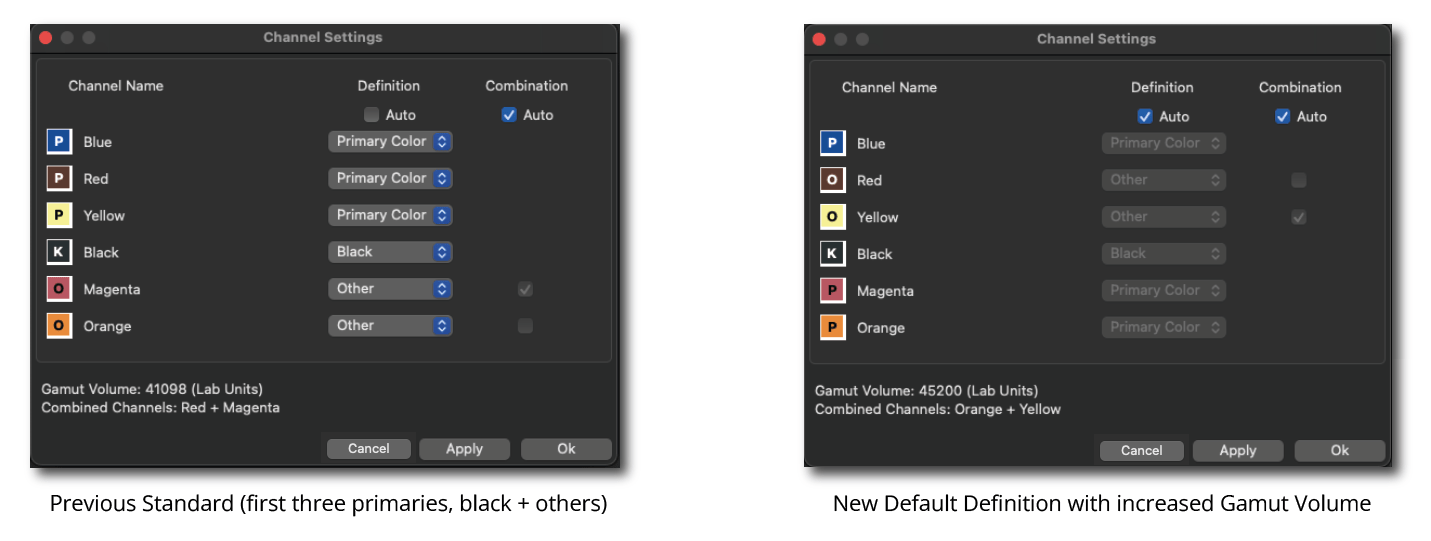
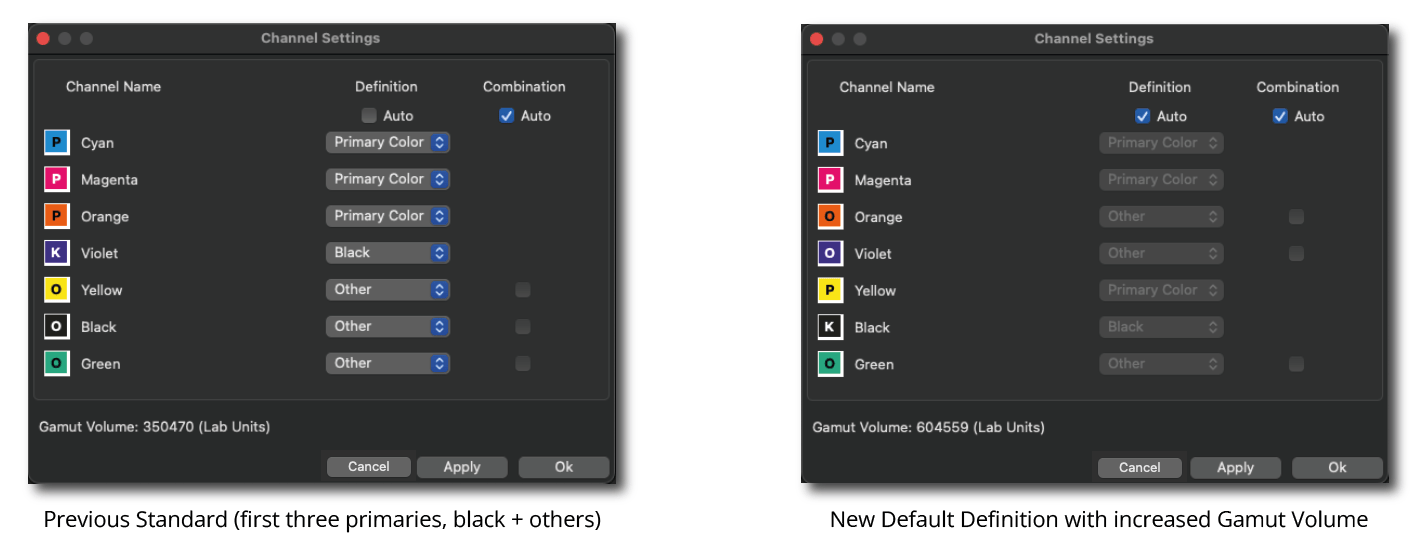
If Auto is enabled, CoPrA automatically calculates and selects the ink definitions and the combinations with the largest gamut. The size of the Gamut Volume and the combined channels are displayed.
Manual Definition: If required, the channels can be manually assigned a custom definition. There are three options per channel available.
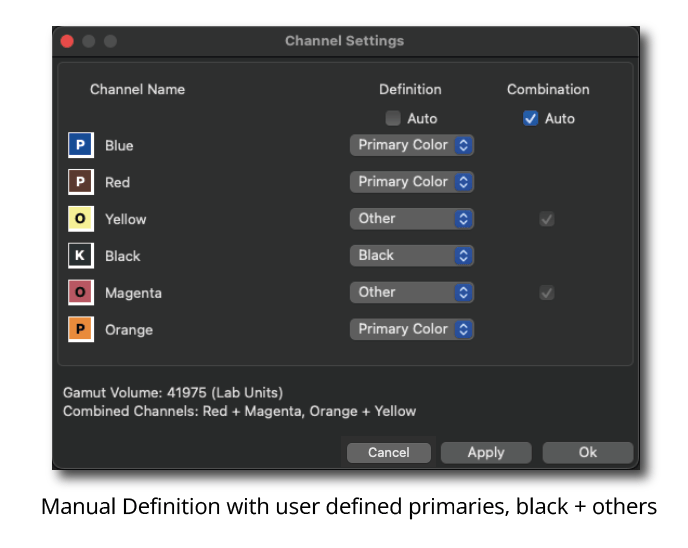
Primary: The data must contain three primary colors.
Black: One channel can be defined as black.
Other: Additional colors get the status Other.
After defining the channels and confirming the settings with Apply the Gamut Volume is calculated and displayed. By clicking OK the changes are applied and the window is closed.
Combination: The channel Combination specifies the Multicolor channels which are to be combined to expand the color gamut. This can be assigned automatically (which is the default for measurement data ≥4CLR) or manually.
Auto: This checkbox is enabled by default for all Multicolor presets. When enabled, CoPrA automatically calculates and selects the ink combinations with the largest gamut and indicates the combined channels. The combined channels are displayed in the Channel Settings window and also below the Curves and Gamut previews. In both previews CoPrA shows the impact of the combined colors by the Gamut Volume number.
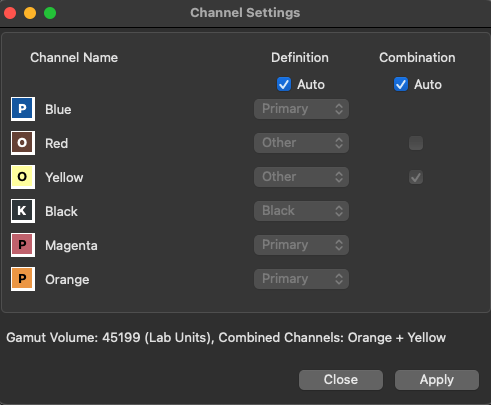
If the Auto checkbox is disabled, the channels can be defined manually by clicking the checkboxes of the desired combinable channels. If the additional inks are not to be combined with the four standard inks, the channels of the additional inks can be disabled.
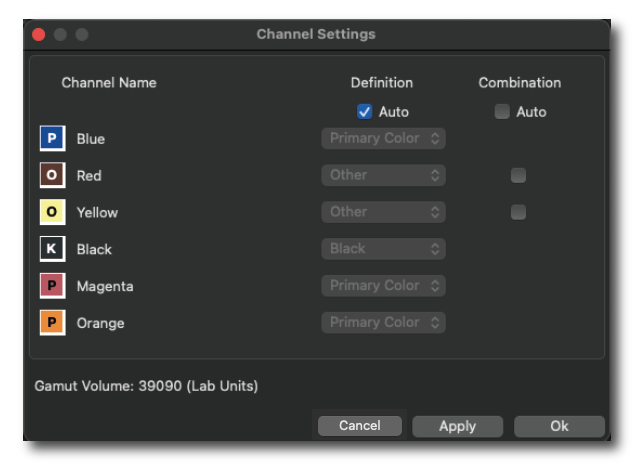
Note: All profile settings, including those from the Channel Settings window, are embedded in the profile, and can be imported and used to reproduce settings by dragging an ICC profile onto the Setting drop-down menu. The name of imported profiles is given the suffix (imported).
Background: The channel Combination option is intended for creating Multicolor printer and DeviceLink profiles used in industrial applications such as ceramic printing, glass or metal decoration or textile printing, with Multicolor inks.
In these industries, special inks different from CMYK are often used in order to increase the color gamut in the shadows and some colorful areas, or to reduce costs.
For example, a dark Red ink can be combined with a Magenta ink of similar hue to extend the color gamut in the dark areas of the ceramic print. Similarly, a light Gray can be used in combination with the Black channel in Flexo printing to create a smoother gradient from light to dark grays.
CoPrA 8 and higher automatically detects if additional inks are either typical gamut-extending colors or special inks and will use them accordingly. For example, two inks with a similar hue but different chroma or lightness can be combined in a single channel.
Example: If the Auto checkbox is activated, CoPrA calculates for the 6 color inks of the example data set (see screenshot) that the second channel (Magenta) can be combined with the 5th channel (a dark Red ink) to increase the gamut in the dark areas.
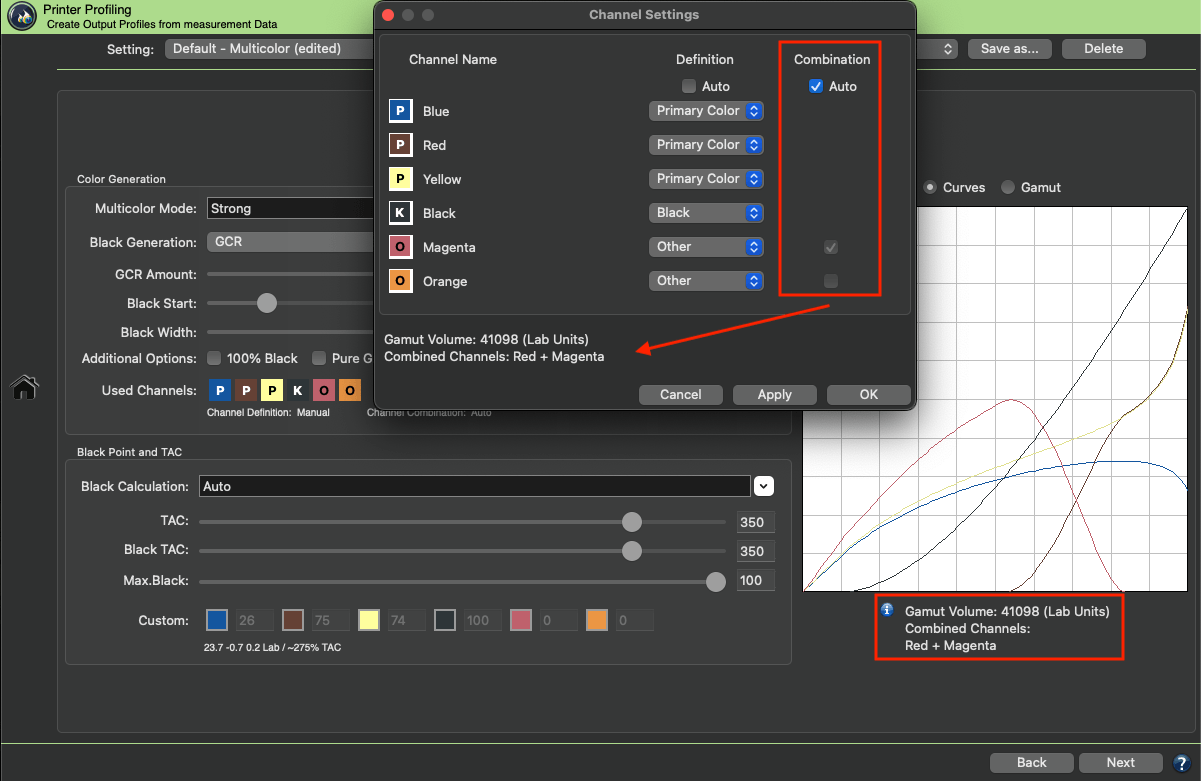
The Curves show that Magenta is used for lighter colors, while more of the dark Red channel is used for darker colors with the Magenta channel being reduced to a minimum.
On the other hand, the 6th channel (Orange) is a typical gamut-extending color and as such is automatically used by the selected Multicolor Mode in the Magenta-Yellow range of the color space.
The Auto function determines the best combination of additional inks and their combination with the 4 standard inks to achieve the largest color Gamut Volume.
Note: Typical gamut-extending colors used in ECG printing such as Orange, Green or Violet can not be combined with the 4 standard inks (CMYK).
In industrial printing, it may be necessary to use combinations other than those recommended by the Auto function. By deactivating the Auto checkbox you can select custom channel combinations, provided that a combination of inks is applicable.
Regarding the example in the screenshot, when the Auto checkbox is deactivated and channels can be combined, Magenta and dark Red are combined, and Yellow and Orange are combined, resulting in two channels under Combination.
If the dark Red channel is disabled under Combination, only the Yellow and Orange inks are combined. Switching to the Gamut view allows comparing the impact of the combinable channels on the Gamut Volume number.
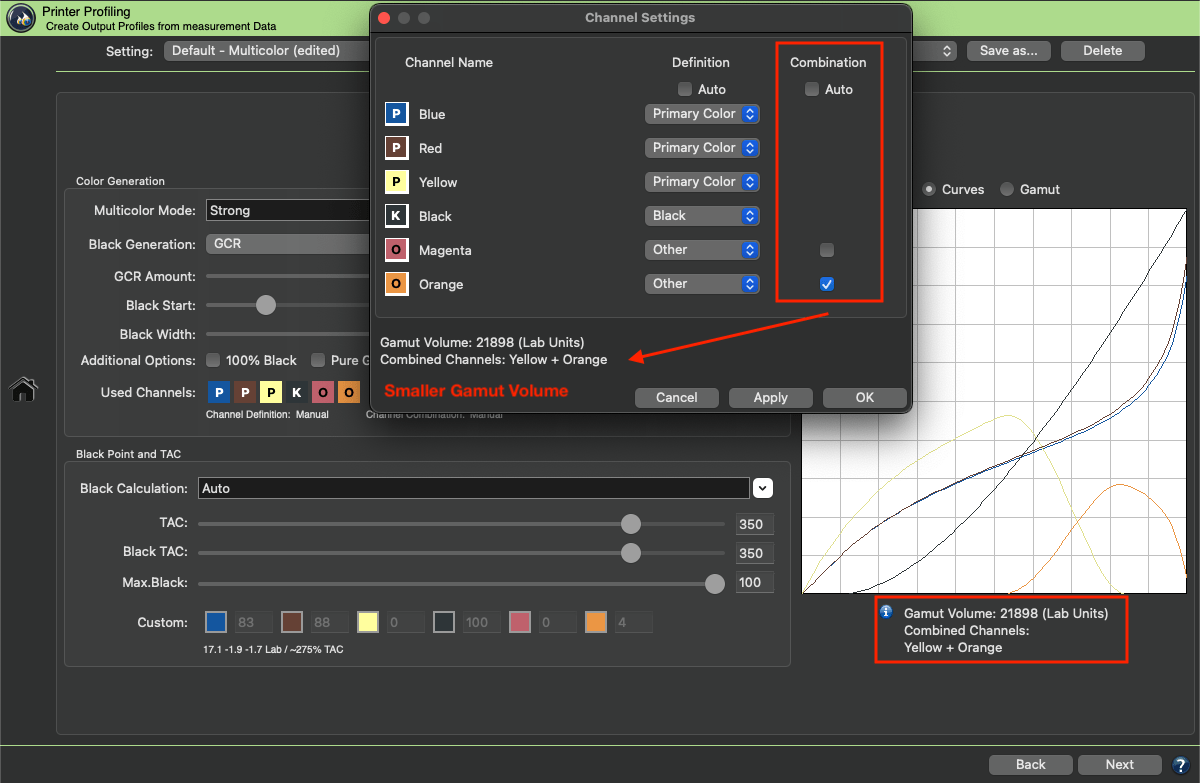
Note: The channel Combination differs from the Used Channels! Channels that are disabled under Used Channels are not used in the separation. Usually, it is recommended to use all channels and not to disable any channel if you want to combine channels.
It is recommended to use the default Auto setting for the channel Definition and Combination, as it automatically calculates and selects the ink definition and combinations with the largest gamut and indicates the combined channels.
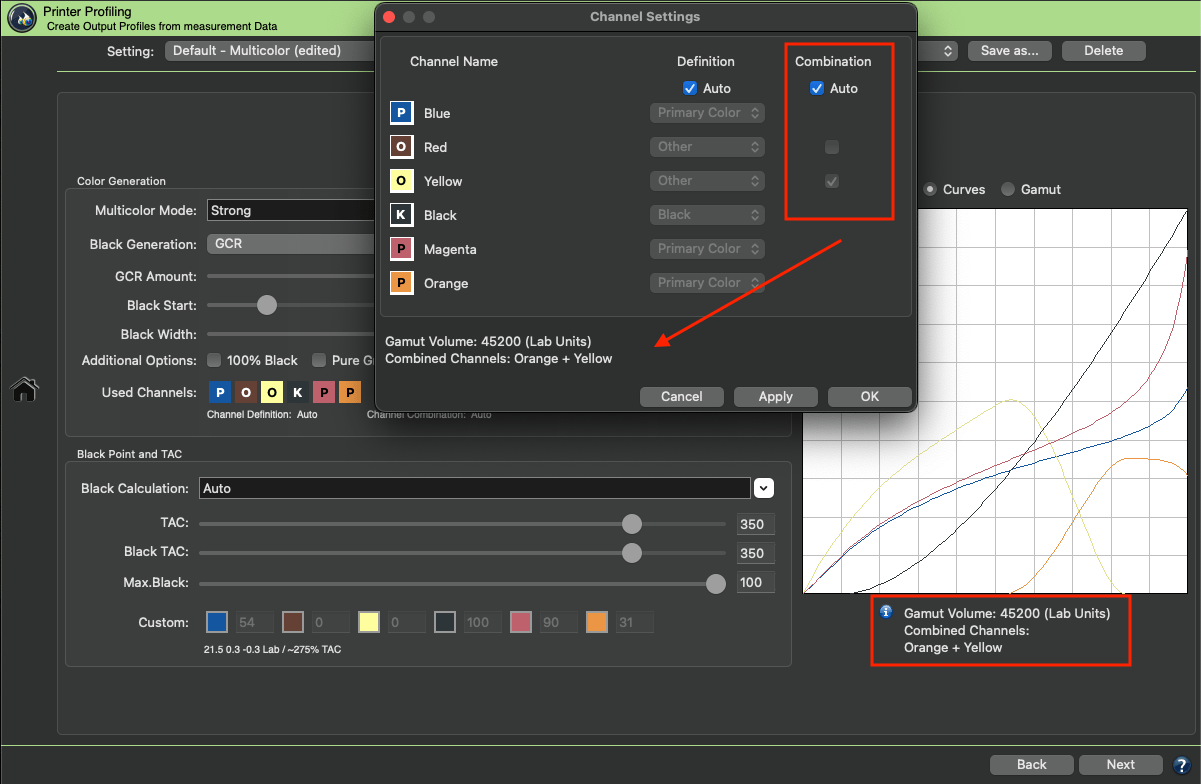
In our example the Magenta and Orange channel will be used as a Primary Color and Yellow is now combined with Orange.
Graphic: Visualizes the effects of the selected color separation and Black Point settings. Provides a real time preview of the loaded measurement data when altering settings.
Black Point and TAC
In the panel Black Point and TAC you can define the overall Total Area Coverage (TAC) and the TAC for the black point (Black TAC). The black TAC represents the darkest color value of the profile which is usually identical with the maximum TAC. The graphical display of each color contains a number field showing the amount of ink used in the profile. Depending on the selected Black Calculation the number fields are either enabled or disabled.
Note: The default window size sometimes truncates the input fields for Multicolor channels. Enlarge the window to display the input fields for all colors.

Black Calculation: Five different settings available for DeviceLink profiling (see screenshot below).

Black Calculation methods
Auto: The calculation of the optimal black point (dark and neutral) is based on the target profile. The values entered for Black TAC and Max.Black define limits which are not exceeded but may be lower if technically possible. All channels are used to generate the black point (Black TAC), therefore individual channel editing is disabled. This mode will not use any Multicolor channels beside the first four channels (usually CMYK).
Note: If no default value for the Black TAC is defined, it is recommended to use 400% as a starting point for the calculation.
Balance CMY: This setting adapts the CMY values to a pre-defined Max.Black value and generates a neutral black point. Define the Black TAC and TAC in accordance with the printing conditions. The Max.Black should be set to the ideal value for your substrate. Similar to the setting Auto those values are regarded as maximum values which may be underrun if a neutral black point is not achievable. Allows customization of the black channel (or in general the 4th channel) and the addition of Multicolor channels.
Note on excluding channels: Basically Balance CMY allows editing of the black channel (or in general the fourth channel) and the Multicolor channels. The CMY channels are grayed out (see screenshot).
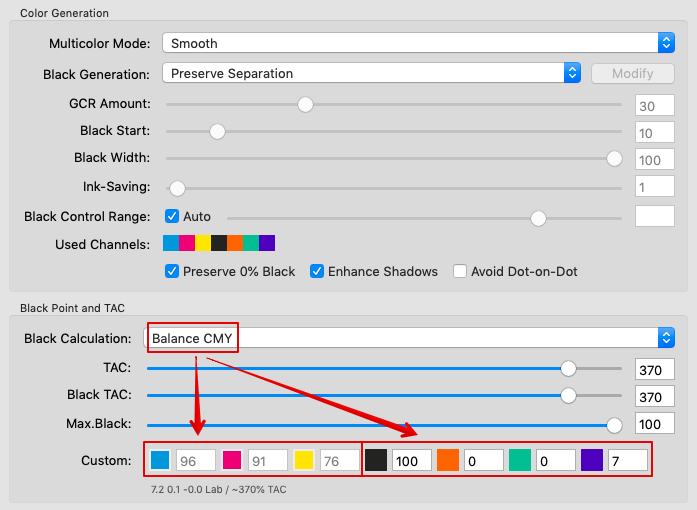
However, if a channel is excluded, the Multicolor channels are searched for a replacement color that can compensate for the missing channel in the gray balance. The replacement Multicolor channels are grayed out in the control panel Black Point and TAC (see screenshot).
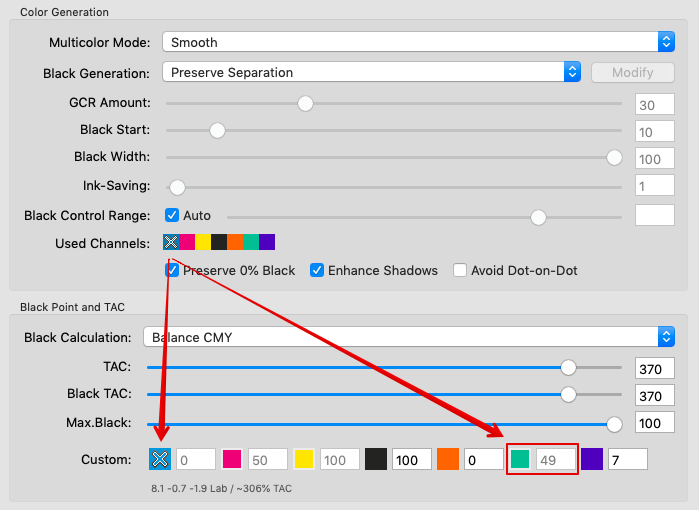
Darkest: Calculates the darkest possible black point with maximum density/lowest L*. Allows generation of a black point without neutral a* and b* values and darker L* if available.
The values entered for Black TAC and Max.Black define limits which are not exceeded but may be lower if technically possible. Darkest uses the first 4 channels, usually CMYK. Possible Multicolor channels are added, but cannot be changed manually. If this is required, the Custom option must be selected.

Custom: Allows to define the black point in the input box Custom as CMYK values. The Black TAC value will then be recalculated. Allows editing of all channels.
Notes:
- CoPrA calculates the Lab values based on the entered custom values. When changing custom values the resulting effects can be seen immediately. If you prefer CoPrA’s recommendations select the settings Balance CMY or Auto.
- For Multicolor profiles with more than four channels you can use the extra Multicolor channels for the black generation besides the first four channels (typically CMYK). However, the total area coverage (TAC) cannot exceed 400%. Values for the Multicolor channels can be entered manually when using the settings Balance CMY or Auto and these values will then be used to calculate the Black TAC. Usually it is not necessary to use those channels but sometimes a dark Multicolor channel adds desired contrast and definition. This can easily be checked by viewing the Lab values below the Custom fields. If the addition of a certain Multicolor channel decreases L* while a*b* values are not significantly altered, using this channel can be considered. However, the gray balance will use additional channels as well.

Note: Neutral a* and b* values are the basis of the Black Calculation when selecting the settings Auto or Balance CMY. In contrast, selecting the setting Custom allows generation of a black point without neutral a* and b* values.
Target Profile: Calculates a black point based on the values of the target profile. The values for the calculation will be displayed and all sliders will be grayed out.
Note: For the Channel Definition and Channel Combination it is shown whether they have been set automatically (Target Profile (Auto)) or manually (Target Profile (Manual)) when creating the profile in CoPrA.
3rd party profiles are always shown as Target Profile (Manual).
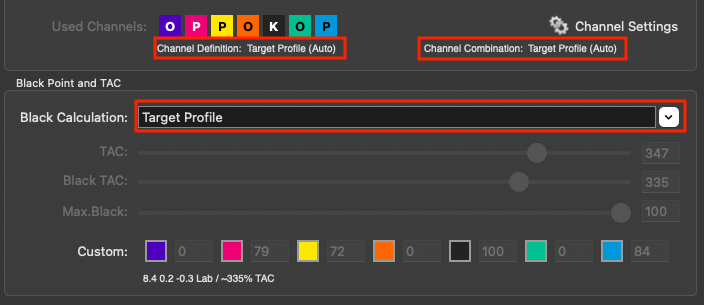
Auto based on Target Profile: Uses the TAC and the Black TAC from the target profile but corrects the Max.Black to 100%. The black point is optimized as for the Auto method in order to achieve a dark and neutral black point. The values for the calculation are displayed and all sliders are grayed out.

Black point using Target Profile

Black point using Auto based on Target Profile
Total Area Coverage (TAC) and Black TAC
Many modern printing systems allow a black point that is generated by using a low amount of ink. Sometimes the darkest color can be printed using pure black which means in extreme cases a black point of 100% K may be sufficient. Obviously, such a low TAC does not work for other color areas – it would not even be possible to print a true red, green or blue! Therefore we separated the Black TAC from the general TAC. This allows use of the best setting for Black Calculation without restricting the color space.
TAC: Defines the value for the maximum total area coverage (value range: 0 to 400%). This value will not be exceeded. This also applies to Multicolor profiles. The TAC can also be set for 2 or 3 channel profiles.
Note: The sliders limit each other, so the TAC can never be lower than the Black TAC (but it can be higher).

Black TAC: The Black TAC is the sum of all color values. The value resulting from your settings for the black point (Black TAC) is displayed after a short calculation under the Custom text field next to the calculated Lab value in percent (red frame in the screenshot below).

The Lab value is particularly handy for assessing the effect on the black point when changing the TAC or Black TAC. The smaller the L* value, the deeper the black and the higher the contrast.
Max.Black: Here you specify the maximum amount of black ink to be used by the separation (value range: 0 to 100%). Note that the entered value always refers to the fourth channel which, in Multicolor cases, may not be black but a chromatic color. Furthermore, the fourth channel of the Black TAC is always used for the darkest point of the profile, the black point.
TAC and Black TAC can be adjusted separately in CoPrA
The total area coverage (TAC), defined by the separation, and the black TAC are identical in traditional printing systems, however, industrial printing applications and many digital printing systems show that the black point can be selected much lower than the total area coverage. To achieve a sound gray balance with a high contrast while maintaining highly saturated colors it is necessary to separate these two settings.
Advantages of a separate Black TAC
The importance of adjusting the Black TAC independently from the total area coverage (TAC) is demonstrated using a digital printing system. Let’s assume the Black TAC and the TAC could not be set separately and we had to use identical values for both of them. If you selected the mode Auto to calculate the black point and set a TAC of 300% (and therefore a Black TAC of 300% as well), CoPrA would calculate the best black point for this case. The result would be a total area coverage of 275% with a neutral black point (a* and b* are 0 respectively), but with a very light L* of 22.0 (outlined in red in the screenshot).

However, CoPrA allows to set the Black TAC separately from the total area coverage (TAC). As pure black is used in some digital printing systems as the darkest printing color, the Black TAC can be reduced to 100% which results in a black point with a significantly darker (lower) L* value of 9.8. Using a separate setting for the Black TAC achieves a significantly higher and better contrast than a TAC which is linked to a Black TAC of 275%. Additionally, a total area coverage (TAC) of 300% ensures highly saturated colors. These precise settings are only possible with separate TAC values.

Profile Processing
Format, Size and Further Processing
In the last step of profile creation, assign a Name and choose the Format and Size of the profile (see screenshot).
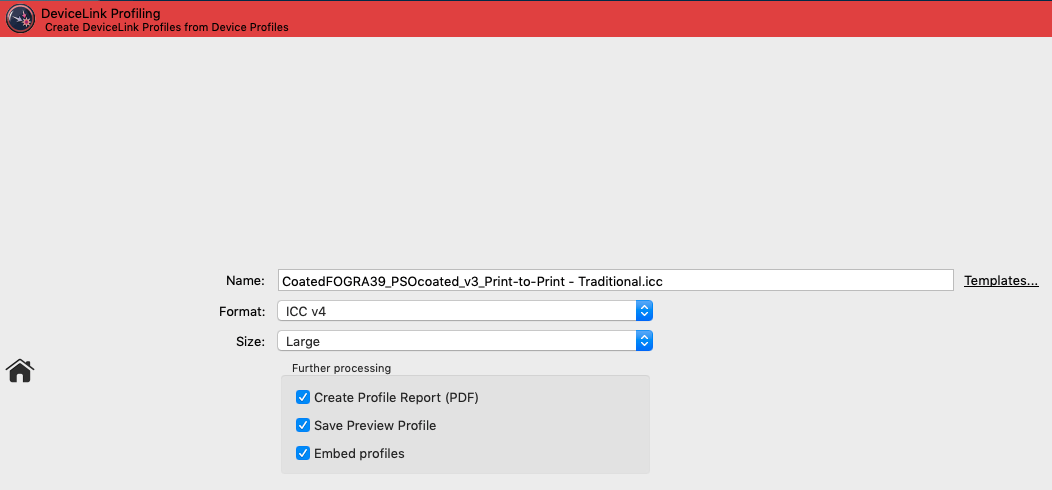
Name: Type in a Name for the profile.
Templates: Allows to select and combine name components from a list of options and save them as custom templates. The last selected template is used when creating new profiles, so the naming of profiles is automated.
Available naming options depend on the current profile type and include Date, Date/Time, Measurement data file name, Source and Target profiles, Name of the current preset and others. Each name component can be added at a user-defined position under Template (the position is selected with the mouse pointer). The Example section below shows the resulting name. Additionally, user defined text can be added at any position within the Template field.
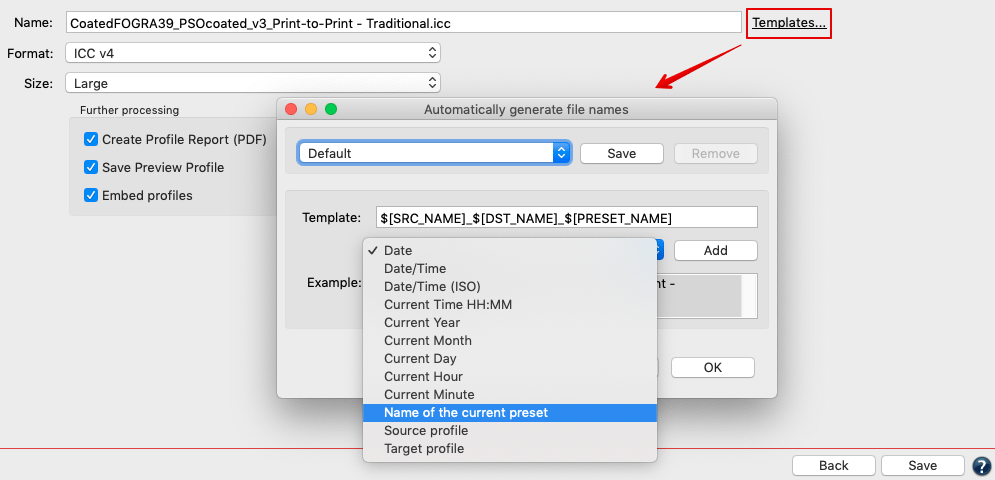
Format: Define the Format of your profile. An ICC format in accordance with specification v2 is recommended as basic setting however, the newer format ICC v4 can also be chosen. In this case, please ensure that your programs support this format.
Note: ColorLogic products handle and use ICC v4 profiles consistently and correctly.
Size: The setting Large is recommended. The size specifies the number of grid points in the profile and determines the amount of disk space required for the generated profile. Small profiles should only be used for test purposes. Very Large profiles can slow down further processing in subsequent programs. Additionally, some programs are not able to handle very large profiles.
Further processing
Create Profile Report: Recommended to activate. The PDF report provides an overview of the quality of the profile based on statistics, diagrams of gray balances, gradients and gamut representations as well as color separations of converted test files.
Under Preferences, the Default save path for the reports and the Default report format can be selected. If XML is selected as the format, the corresponding XSD files will be created automatically as well.
Save Preview Profile: Is only available in Multicolor printer profiling. By activating this checkbox an ICC preview profile will be created in addition to the printer profile. It can be used as a soft proof profile in Adobe Photoshop.
Notes: Preview profiles are only suitable for proofing purposes. Either a preview profile or a CMYK profile can be created in one profiling step, but not both.

Embed profiles: Physically incorporates the used source and target profiles into the DeviceLink. This function is tricky and only recommended if the DeviceLink has to be transferred to a computer which does not have the required source and target profiles. It was implemented mainly for use with certain RIPs which only accept DeviceLinks with embedded source and target profiles.
Save: Creates the printer profile and saves it in the folder Profiles (macOS) or Color (Windows), (macOS: /Users/Username/Library/ColorSync/Profiles, Windows: C:\\Windows\\System32\\spool\\drivers\\color). Demo and encrypted profiles will be saved in a different location only relevant for ColorLogic applications.
Note: CoPrA-SP profiles are stored in the ColorLogic subfolder Licensed-Profiles.
Preview Profiles
Introduction: Using Preview Profiles for Soft Proofs
Preview profiles allow soft proofing of image files in DeviceLink profiling and Multicolor printer profiling, without converting a file. Multicolor preview profiles provide a true color representation of images to be converted into the Multicolor color space in order to review the achievable result prior to the actual Multicolor conversion (More information can be found further down in the text). The same applies to DeviceLink conversions. Here, too, the DeviceLink preview profile can be used in Photoshop with the original data to visually review how the result of such a conversion would look like.
Preview profiles can be created together with DeviceLink or Multicolor printer profiles by activating the checkbox Save Preview Profile (see screenshots). Preview profiles have the suffix ‘preview‘ and are saved in the folder Profiles (macOS) or color (Windows), (macOS: /Users/Username/Library/ColorSync/Profiles, Windows: C:\Windows\System32\spool\drivers\color). Right clicking on the preview profile and selecting the menu entry Show file in the context menu will take you directly to the location of the selected profile.
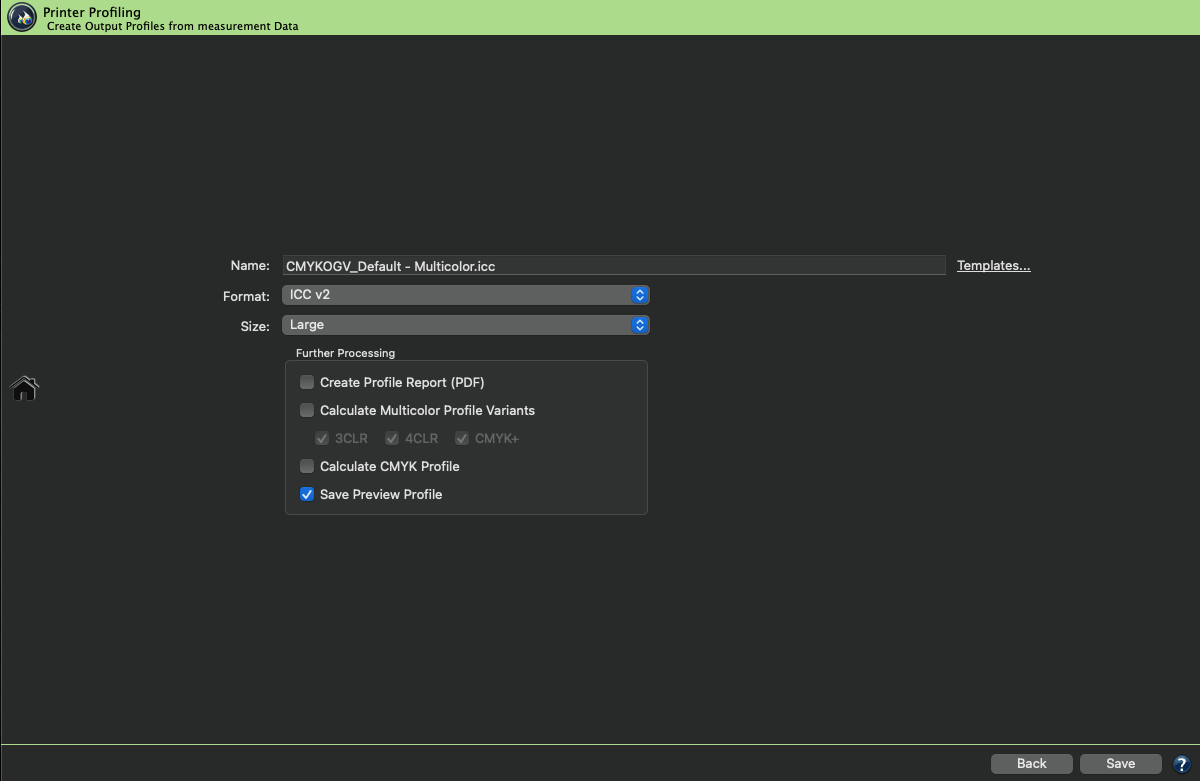
Creating preview profiles in Multicolor printer profiling
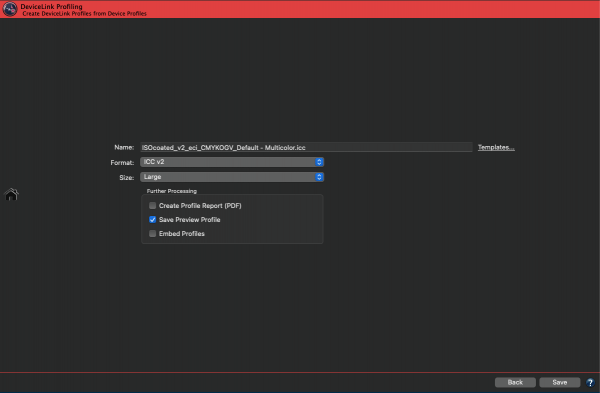
Creating preview profiles in DeviceLink profiling
A preview profile is a printer profile with the same color space as the source profile of the DeviceLink. It can be used as soft proof profile, for example in Adobe Photoshop. Preview profiles can be created for the following DeviceLink combinations:
RGB-to-CMYK, CMYK-to-CMYK, RGB-to-Multicolor and CMYK-to-Multicolor
Note: The creation of preview profiles is not available for DeviceLink profiles using more than four channels in the source color space since only preview profiles of the color spaces Gray, RGB or CMYK can be used in Photoshop. Multicolor printer profiles are not affected as their preview profiles are always RGB profiles which can be used in Photoshop.
Example: To adapt your RGB image data in RGB mode to the desired CMYK printing condition, use the preview profile of your RGB-to-CMYK DeviceLink as soft proof profile in Adobe Photoshop to check how the image would look like after the conversion. This allows specific RGB adjustments without the need to convert the RGB file early on. A preview profile is a very useful feature, particularly in view of storing RGB image data in media-neutral workflows.
Preview profiles can also be created for Multicolor printer profiles which allows a true color simulation of the color representation prior to application of the Multicolor profile. Although Adobe Photoshop CS4 or higher is able to convert image data using Multicolor profiles, the display of multichannel files is not a true color representation in Photoshop. So far, a true color representation of multichannel files is only possible using additional plug-ins and causes an increased workload. The preview profile function generates an RGB printer profile which features the same color visualization as the original Multicolor profile. Use this preview profile on an original image data for soft proofing.
Note: Preview profiles are only intended for soft proofs and should never be used for the actual conversion. A preview profile provides an excellent visual preview of the expected result of a DeviceLink conversion. However, the special features of the DeviceLink, such as preserving color purity, cannot be 100% emulated.
Using Preview Profiles for DeviceLinks in Adobe Photoshop
- Open the original image data to be converted using a DeviceLink profile in Adobe Photoshop.
- Either assign the Preview profile from CoPrA to this image file, or select the Preview profile in the dialog Customize Proof Condition as Device to Simulate (see screenshot).
Note: The color space of the preview profile is based on the color space of the DeviceLink’s source profile. It is an RGB preview profile for RGB-to-CMYK DeviceLinks and a CMYK preview profile for CMYK-to-CMYK DeviceLinks. - Click Preserve CMYK Numbers to get a virtually exact preview of the expected color representation for the DeviceLink conversion.
Note: Pipette values do not correspond to the final DeviceLink conversion. Only the color representation in the soft proof does.
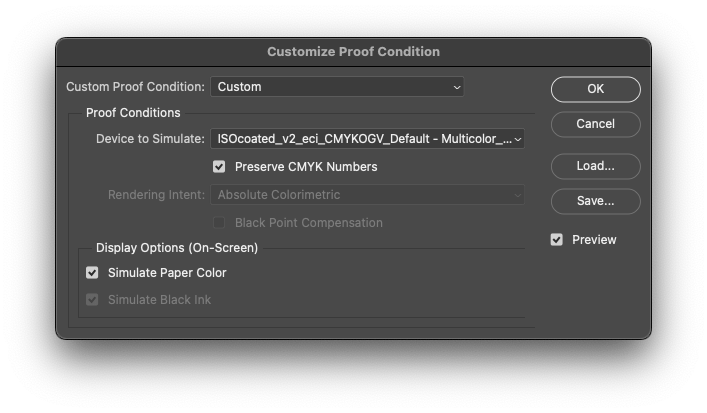
Using Multicolor Preview Profiles in Photoshop
- Open the original image data to be converted using a Multicolor printer profile in Adobe Photoshop (for example an RGB image).
- Select the Preview profile from CoPrA in the dialog Customize Proof Condition as Device to Simulate. Find the profile in the list of RGB profiles. The naming is based on the Multicolor profile name: Profile name_preview.icc
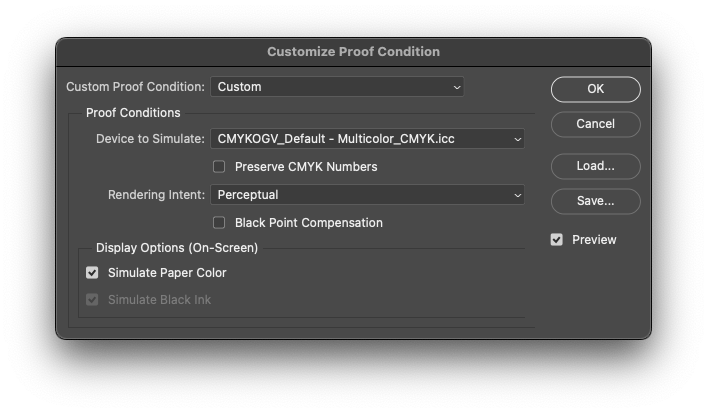
- Select the desired Rendering Intent and disable the checkbox Preserve RGB/CMYK Numbers.
Note: Eyedropper values do not correspond to the final DeviceLink conversion. This is only for a soft proof.
Profile Reports
Profile reports can be created for Printer or DeviceLink profiles. To do so, activate the checkbox Create Profile Report in the last step of the profiling or, when updating profiles, the checkbox Create Profile Comparison Report.
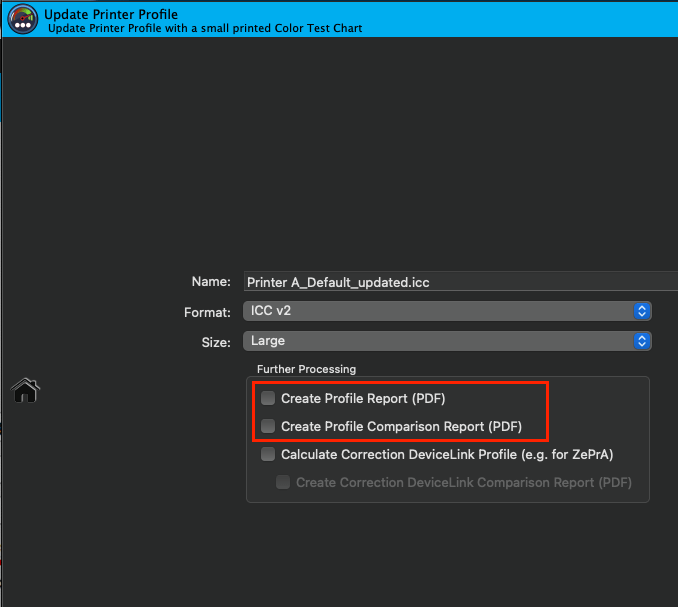
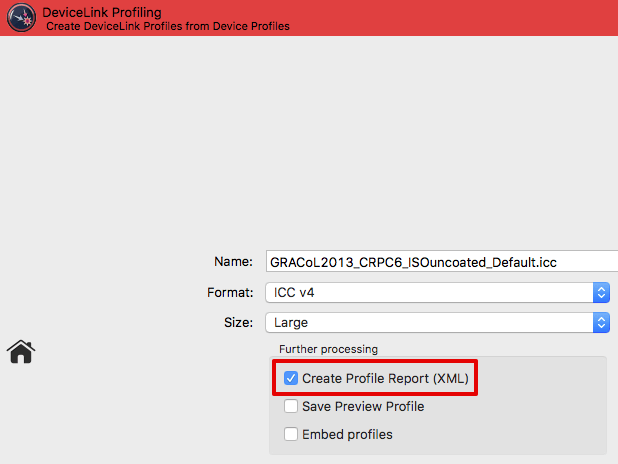
Depending on the type of profile the report contains various statistical data, such as statistics about profile precision (Integrity, Precision, Black Point, White Point etc.), graphic representations of curves and gamuts (Gray Balance, Gradients etc.), conversions of test images, separations and color patches to evaluate the smoothness or the purity of colors. All this facilitates the detection of artifacts that may be present.
Profile reports can be created at any time in Batch Overview or in Profile Manager which, by the way, is not restricted to ColorLogic profiles.
Under Preferences you can define some basic settings for the creation of the profile report, such as the Default save path, the Default report format (PDF or XML) or the DeltaE method (dE76 or dE2000). If XML is selected as the format, the corresponding XSD files will be created automatically as well.
Note: If a profile comparison report is created when updating a profile, the measurement data obtained from the update test chart will be compared to the data of the original profile (reference profile).
If the checkboxes Brightener Compensation or Measurement Correction have been activated, the data of the original profile will not be compared to the measurement data from the update test chart but to the data modified by these options.

